Dual-Channel Benchtop Optical Power and Energy Meter Console
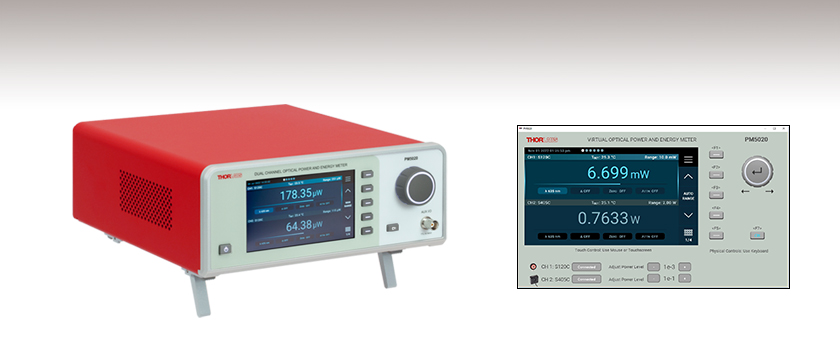
- Fast Data Acquisition and Visualization Up to 100 kS/s
- Configurable Analog Outputs with Smart Signal Correction
- USB, Ethernet, and RS232 Remote Control as Well as Web Browser Monitoring
- All Functions Accessible by Both Touchscreen and Physical Controls
PM5020
Benchtop Optical Power and Energy Meter Console
Interactive GUI Available to Demo All Features of the PM5020 Console

Please Wait
| Item #a | PM5020 |
|---|---|
| Compatible Sensors | Photodiode Power, Thermal Power, Thermal Position and Power, and Pyroelectric Energy |
| Number of Channels | 2 |
| Optical Power Rangeb | 100 pW to 200 W |
| Optical Energy Rangeb | 10 µJ to 15 J |
| Available Sensor Wavelength Rangeb | 185 nm - 25 μm |
| Display Refresh Rate | 25 Hz |
| Bandwidtha | DC - 250 kHz |
| Photodiode Sensor Measurement Rangeb,c | 2 nA - 10 mA |
| Thermopile Sensor Measurement Rangeb,c | 2 mV - 1 V |
| Pyroelectric Sensor Measurement Rangeb,c | 20 mV - 100 V |
| Power Meter Selection Guide |
|---|
| Sensors |
| Photodiode Power Sensors |
| Thermal Power Sensors |
| Thermal Position & Power Sensors |
| Pyroelectric Energy Sensors |
| Power Meter Consoles and Interfaces |
| Digital Handheld Consoles |
| Analog Handheld Console |
| Touchscreen Handheld Console |
| Dual-Channel Benchtop Console |
| USB Interfaces with External Readout |
| Complete Power Meters |
| Power Meter Bundles |
| Wireless Power Meters with Sensors |
| Compact USB Power Meters |
| Field Power Meters for Terminated Fibers |
Features
- Large 5" Graphical Touchscreen Display with WVGA Resolution
- Built-In GUI Features:
- CW and Modulated Light Measurements
- Fast On-Board and Remote Data Acquisition Up to 100 kS/s
- Apply User-Provided Spectral Calibration and Attenuation Correction to Measurements
- Built-In Calculator can Perform Cross-Channel Math Functions
- Interactive GUI Available to Demo All Front Panel Features (See Interactive Demo tab)
- Device Inputs/Outputs:
- Configurable Analog Outputs
- Optical Shutter Control
- Connect Up to Two External Temperature Probes and Two Fans
- Digital I/O Interface Including User-Accessible I2C Bus
- Remote Operation and Network Capabilities Via USB, Ethernet, or RS232
- View Console Measurements via Web Browser on PCs within the Same Network
- Compatible with All Thorlabs' C-Series Sensors
- Optical Power Monitor PC Software Available (See Software Tab for Details)
Thorlabs’ PM5020 Dual-Channel Power and Energy Meter Console is ideal for precise optical measurements, laser and photodiode characterization, lifecycle measurements, and many more applications in the lab and on the manufacturing floor. The high-resolution 5" touchscreen can be configured for various single- and dual-channel measurement, visualization, and data acquisition views (see the Display tab for more details). Aside from the touchscreen, the console has five dynamic side menu buttons, a channel button to quickly switch the display between sensor 1 and sensor 2, as well as a rotary navigation knob. An interactive GUI is available to demo all the front panel features (click here or see the Interactive Demo tab). The screen and buttons are also backlit and can be dimmed for operation in dark environments. The fast boot time of approximately 3 seconds, including the calibration data read out from the connected sensors, means that the device is ready to go at any time.
Users can enter and save up to twelve attenuation values or data files to correct for effects that external devices (such as filters or beamsplitters) may have on the power or energy measurement. Measured data, calibration information, screenshots, and attenuation curves can all be saved to the unit's internal 8 GB memory. The user can export the saved data to the connected PC via USB or using the Ethernet connection and the web interface (see the Display tab).
Sensor Compatibility
The PM5020 console is compatible with more than 35 photodiode power, thermal power, thermal position and power, and pyroelectric energy sensors designed for use from the UV to the Mid-IR. See the Sensor Selection tab for further information. The console also allows the connection of unamplified anode or cathode grounded photodiodes with up to 10 mA photocurrent, thermal elements with up to 1 V output voltage, and pyroelectric detectors with up to 100 V output voltage. Special modes for photodiode sensors can be used to measure the peak power of modulated signals or pulses down to a 10 μs pulse width with a sampling rate up to 100 kS/s. Pulse energy measurements with pyroelectric sensors are supported up to a repetition rate of 80 kHz.
The PM5020 power and energy meter console is sold as a single benchtop device with the sensors available separately. The compatible sensors are offered below. To view the full range of Thorlabs' power and energy meter consoles, please refer to the Console Selection tab.
Connectivity
For each channel, the PM5020 power meter has a configurable, wavelength- and offset-corrected analog output (AN1 and AN2). For thermal power and position sensors, the X1, X2, Y1, and Y2 digital-to-analog converter-controlled outputs each provide a voltage that corresponds to the beam position in X (X1, X2) or Y (Y1, Y2). For power or energy sensors, the X1 and X2 outputs for each channel can export a voltage proportional to the power or energy level; the Y1 and Y2 outputs provide a voltage resulting from a calculation performed on the signal using a mathematical formula in the settings menu. The Y1 and Y2 outputs can also be configured to provide an analog signal from up to two connected negative temperature coefficient (NTC) thermistors.
Thorlabs' SH05R(/M) or SH1(/M) optical shutters can be directly connected to the console using the Hirose cable included with the shutters. The shutters can be controlled and monitored either manually via the user interface or through a TTL signal.
Two external NTC thermistors such as the Thorlabs TSP-TH can be connected to the 2.5 mm stereo audio or the 10-pin PCB connector in the back panel. Their readings can be displayed or logged.
Two fans up to 12 V can be connected to a 10-pin PCB connector in the back panel. The fan speed can be controlled by three settings: the operating voltage, the revolutions per minute (rpm) if tachometer feedback from the fan is provided, or the temperature when coupled with an NTC input. This connector can be used as a power supply for fan-controlled power sensors such as the S322C thermal sensor.
The user-accessible 10-pin PCB digital port provides 5 V tolerant LVTTL/TTL logic. Four general input/output (I/O) pins can also be configured for additional functions such as pass/fail testing or shutter control and monitoring. A separate trigger input and output pin can support synchronized measurements. An I2C bus pin supports additional humidity and temperature sensors (see the manual for details). See the Front & Back Panel tab for details.
Remote Console Control
Three different interfaces are provided for remotely controlling the PM5020 console: high-speed USB interface, Ethernet, and RS232. All three interfaces allow the console to be fully controlled through Thorlabs' Optical Power Meter (OPM) Software. The PM5020 console can be integrated into custom made systems with the help of the provided SCPI commands and drivers. See the Software tab for details. Additionally, the Ethernet connection allows the console measurements to be viewed within a web browser on any PC within the same network (see the Web Browser View in the Display tab).
Sensor Upgrade Service
Thorlabs' PM5020 Console is not compatible with previous-generation A- and B-series sensor heads. We offer a sensor upgrade service to make your existing sensors compatible with a new power meter console. Note: upgraded sensors will be incompatible with old power meter consoles and new sensors converted to work with older consoles will not be compatible with the PM5020 console. Please contact our Tech Support team for details.
Recalibration Services
Thorlabs offers recalibration services for the PM5020 console electronics, our photodiode and thermal power sensors, and our pyroelectric energy sensors. We recommend recalibrating your Thorlabs sensor and console as a pair; however, each may be recalibrated individually. The energy meter console and all of the sensors on this page come with a manufacturer calibration by default, but we also offer an ISO 17025 accredited calibration for some items. For more information on calibration options, please see the Recalibration tab or the calibration sections at the bottom of this page.
| Specificationsa | |
|---|---|
| Display | |
| Type | Graphical IPS LCD with Touch, 854 x 480 Pixels |
| Format | Numerical, Bargraph, Needle, Graph Power/Position/Temperature, Statistics |
| Size | 5.0" (4.32" x 2.43", 109.7 mm x 61.6 mm) |
| Update Rate | 25 Hz |
| Sensor Interface | |
| Compatible Sensors | Thorlabs' C-Series Photodiode, Thermal Power, Thermal Position & Power, and Pyroelectric Sensors Photodiodes up to 10 mA Thermopiles up to 1 V Pyroelectric Sensors up to 100 V See Table Below for Additional Details |
| Channels | 2 |
| Input Connectors | Two DE-9 Female, Back Panel (Compatible with C-Series Connectors) |
| External Trigger | |
| Connector | BNC, Front Panel (TTL 5 V Max) 10-Pin PCB, Back Panel (TTL 5 V Max) |
| Analog Outputs | |
| Connector | Two BNC, Back Panel |
| Signal | CH1, CH2 Amplified, Corrected Input Signal |
| Voltage Range | -2.5 V to 10 V |
| Bandwidth | Up to 250 kHz, Dependent on Sensor and Settings |
| Programmable Analog Output | |
| Connector | Four BNC, Back Panel |
| Signal | Selectable: CH1; CH2; CH1-CH2; CH1/CH2; Position X, Y |
| Voltage Range | -5 to 10 V; Programmable Gain and Offset |
| Bandwidth | Up to 1 kHz, Dependent on Sensor and Settings |
| Shutter Control | |
| Type | Support for SH05R(/M) or SH1(/M) Optical Shutter with Interlock Input |
| Connector | Hirose HR10-7R-6S, 2.5 mm Mono Audio |
| Power Rating | 15 V, 0.5 A |
| Temperature Control | |
| Type | NTC |
| Connector | 2 Channels: 2.5 mm Stereo Audio and 10-Pin PCB (Back Panel) |
| Digital I/O | |
| Type | 4 Configurable I/O Channels, 1 Trigger In/Output, I2C (LVTTL / TTL) |
| Connector | 10-Pin PCB, Back Panel |
| Fan Control | |
| Type | 2 Channels, Voltage or rpm Control (12 V, 0.25 A) |
| Connector | 10-Pin PCB, Back Panel |
| Power Rating | 12 V, 0.25 A |
| Interface | |
| Type 1 | USB 2.0 |
| Connector | USB B, Back Panel |
| Type 2 | Ethernet |
| Connector | RJ45, Back Panel |
| Type 3 | Serial RS232 |
| Connector | DE-9 Female, Back Panel |
| Power Supply | |
| Line Voltage | 100 to 240 V |
| Line Frequency | 50 to 60 Hz |
| Maximum Power Consumption | 30 W |
| Mains Supply Overvoltage | Category II (Cat II) |
| General | |
| Dimensions (W x H x D) | 253.2 mm x 110.6 mm x 293.6 mm (9.97" x 4.35" x 11.56") |
| Weightb | 2.6 kg |
| Mounting Options | Benchtop |
| Operating Temperature Rangec | 0 to 40 °C |
| Storage Temperature Range | -40 to 70 °C |
| Relative Humidity | Max 80% up to 31 °C, Decreasing to 50% at 40 °C |
| Pollution Degree (Indoor Use Only) | 2 |
| Operation Altitude | <2000 m Above Sea Level |
Sensor Compatibility Specs
| Item # | PM5020 | ||
|---|---|---|---|
| Detector Compatibility | Photodiode Power Sensors | Thermal Power Sensors Thermal Position & Power Sensors |
Pyroelectric Energy Sensors |
| Measurement Ranges | 21 Ranges: 2 nA to 10 mA Ranges Selectable in W or A, Sensor Dependent |
9 Ranges: 2 mV to 1 V Ranges Selectable in W or V, Sensor Dependent |
12 Ranges: 20 mV - 100 V Ranges Selectable in J or V, Sensor Dependent |
| Wavelength Ranges | 200 nm - 1800 nm (Sensor Dependent) | 190 nm - 25 μm (Sensor Dependent) | 185 nm - 25 μm (Sensor Dependent) |
| Power / Energy Ranges | 100 pW - 20 W (Sensor Dependent) | 100 μW - 200 W (Sensor Dependent) | 10 μJ - 15 J (Sensor Dependent) |
| Bandwidth | DC - 250 kHz, Dependent on Sensor and Settings | DC - 1 kHz, Dependent on Sensor and Settings | N/A |
| Max Repetition Rate | N/A | N/A | 80 kHz |
| Wavelength Correction | Sensor Dependent; nm (A/W) | Sensor Dependent; nm (V/W) | Sensor Dependent; nm (V/J) |
| Units | W, dBm, W/cm2, lx, A | W, dBm, W/cm2, V | J, J/cm2, W, W/cm2 |
| Accuracy | ±0.2% of Full Scale (1 µA - 10 mA Ranges) ±0.5% of Full Scale (2 nA - 400 nA Ranges) |
±0.5% of Full Scale | ±0.5% of Full Scale |
| Display Resolution | 0.1 pA / Responsivity Value (A/W) | 0.1 µV / Responsivity Value (V/W) | 1 µV / Responsivity Value (V/J) |
For a full list of the sensor head specifications please visit the Photodiode Power Sensors, Thermal Power Sensors, Thermal Position & Power Sensors, or Pyroelectric Energy Sensors pages. For other information, please contact Tech Support.
Interactive Demo
An interactive GUI is available in this tab to demo all the features of the front panel of the PM5020 power and energy meter console. A full-screen demo is also available by clicking the button to the right. For computers with a touchscreen, the demo supports all swipe gestures to switch screens. Otherwise, a mouse can be used to interact with these functions. The GUI provides the opportunity to browse all submenus and change settings.
For information on navigating the menus, please see the Display tab above, the PM5020 manual, or, in the GUI, click on the three lines in the top right of the touchscreen, and then select TIPS.
The physical keys can be operated with the function keys <F1> to <F7> on the keyboard. Turning the control knob is done with the left and right arrow keys, and pressing the knob can be accomplished with the Enter key.
The demo GUI simulates operation with a S120C Photodiode Power Sensor and S405C Thermal Power Sensor Head connected to the device. These sensors can be individually disconnected. The simulated measured power levels for these devices can also be set over several decades.
PM5020 Dual-Channel Power and Energy Meter Console Touchscreen Display
The screenshots below provide an overview of some of the measurement settings, measurement views, functions, and calculators accessible through the touchscreen display of the PM5020 console. For an interactive GUI to demo all of the touchscreen features, see the Interactive Demo tab.
| Settings Menus | |||
|---|---|---|---|
| Main Menu | Digital I/O Control Panel | ||
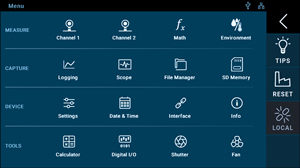 Click to Enlarge |
The main menu gives access to all measurement settings, data handling functions, and local and remote device configuration options. It also includes the laser calculator and settings for the optional accessories. | 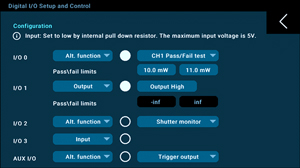 Click to Enlarge |
The digital I/O control panel allows the user to configure the four I/O ports of the 10-pin PCB connector on the back panel. The pin settings are also used for pass/fail testing, disabling the analog outputs, and logging and shutter control. This control panel is also used to configure the BNC AUX I/O port on the front panel to either a TTL input or output. |
| Measurement Views | |||
| Single-Channel View | Dual-Channel View | ||
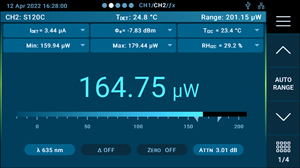 Click to Enlarge |
The numerical display shows a digital measurement of the power or energy with a bar graph along the bottom. The triangles on the bar graph show the min and max values detected during the measurement. The six rectangular subpanels immediately above the power or energy measurement are configurable displays, allowing the user to select additional parameters to view. The four buttons on the bottom give quick access to wavelength correction, delta mode, zeroing, and attenuation correction. |
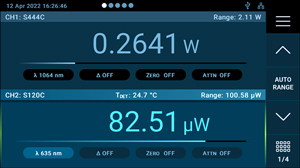 Click to Enlarge |
The dual-channel view shows the measurements from both channels, each accompanied by a bar graph visualization. The channel readings can be configured using the dynamic side menu. The dynamic side menu can only adjust the settings of one active channel at a time. The active channel is marked by either a blue (channel 1) or green (channel 2) indicator on the right-hand side. The four buttons below the bar graph give quick access to wavelength correction, delta mode, zeroing, and attenuation correction. |
| Analog Needle View | Position View (Thermal Position Sensors Only) | ||
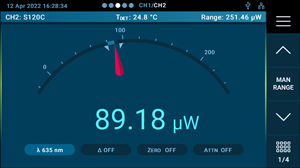 Click to Enlarge |
Measurements can be viewed with a simulated analog needle. The blue triangles are resettable indicators for the max and min measured power. The scale can be zoomed by a factor of 5. In this view, a power level dependent audio signal can be switched on to support tuning. The four buttons on the bottom give quick access to wavelength correction, delta mode, zeroing, and attenuation correction. |
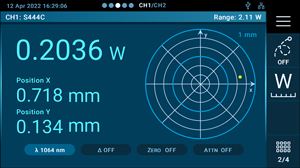 Click to Enlarge |
When used with the S440C or S442C Thermal Position & Power Sensors, the PM5020 console can display the beam position within a Ø1 mm or Ø6 mm circle target representing the sensor surface. An optional trace visualizes the change in position. The total beam power, along with the exact x and y positions, are also displayed in this view. The four buttons on the bottom give quick access to wavelength correction, delta mode, zeroing, and attenuation correction. |
| Data Logging View | Statistics View | ||
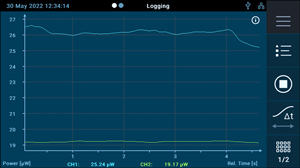 Click to Enlarge |
The data logging view shows the power, energy, or position measurement as a function of time for both channels, as well as the readings for all connected temperature sensors. The measurements shown are sensor-dependent and user-configurable. The measurement interval can be set from 1 ms to 1 s. The start/stop conditions can be configured to manual, time, number of samples, or external signal input. After recording the data, zoom and pan functions allow the user to closely examine the data. | 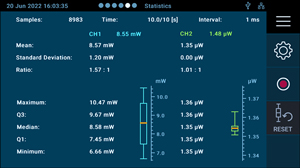 Click to Enlarge |
In parallel with the data logging view, a statistics view shows the mean value, standard deviation, and the max/min ratio of the recorded data. Two boxplots give additional information on the statistical distribution of the data of each channel. |
| Scope View | Graph View | ||
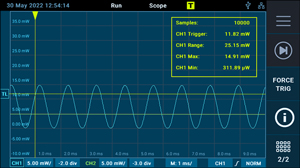 Click to Enlarge |
The scope view is a convenient way to watch alternating or CW power signals. A resolution of 10 µs and a sampling rate of up to 100 kS/s can be achieved. | 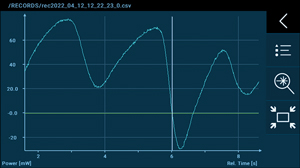 Click to Enlarge |
The graph view allows the user to examine the recorded data. When applicable, it is possible to switch between power, temperature, or position records. To closely examine portions of the graph, use the zoom and pan functions of the display or the rotary control knob. |
| Calculations | |||
| Math View | Calculator View | ||
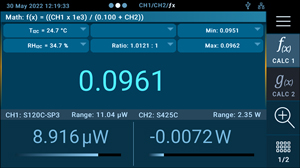 Click to Enlarge |
The math view allows the user to perform independent calculations on one or both channels. This view offers the calculation result based on the live measurement values of each channel (also displayed at the bottom of the panel), and six configurable subpanels. | 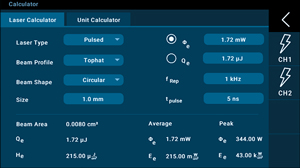 Click to Enlarge |
The PM5020 console features several calculators. The laser calculator screen allows the user to calculate laser beam parameters for CW and pulsed signals. A unit converter provides quick conversions between Watts and dBm or between wavelength, frequency, wavenumbers, and photon energy. The channel wizard buttons import the actual measurement and settings values from channel 1 or channel 2 into the calculator. |
| Web Browser View | |||
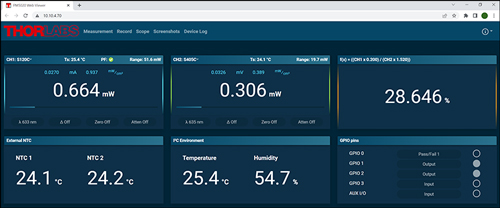 Click to Enlarge |
When the PM5020 console is connected to a network via Ethernet, it is possible to view the instrument by entering the IP address shown in the interface settings to the web browser of any PC within the same network. The displayed website shows the measurement values of both channels, the math view, connected temperature or humidity sensors, and the I/O settings and shutter control. The web browser allows the user to easily download recorded data and screenshots or watch the device log. |
||
Front Panel
Back Panel
| Callout | Description |
|---|---|
| 1 | Display with Touch Screen |
| 2 | Power Button |
| 3 | Side Menu Buttons |
| 4 | Rotary Knob |
| 5 | Auxiliary Input/Output (BNC Female, TTL 5 V Max) |
| 6 | Channel Button |
| Callout | Description | Callout | Description |
|---|---|---|---|
| 1 | Y1 and Y2 Position (BNC Female, -5 to 10 V) |
8 | DE-9 RS232 Connector |
| 2 | X1 and X2 Position (BNC Female, -5 to 10 V) |
9 | RJ45 Ethernet Connector |
| 3 | Analog Out: AN1 and AN2 (BNC Female, -2.5 to 10 V) |
10 | IEC-60320 C14 Power Inlet |
| 4 | DE-9 Sensor Input Connectors | 11 | Type B USB Connector |
| 5 | 10-Pin PCB Connector Digital I/O Terminal |
12 | 4 mm Banana Socket Ground Terminal |
| 6 | 2.5 mm Stereo Audio NTC Connectors |
13 | 2.5 mm Mono Audio Interlock Connector |
| 7 | 10-Pin PCB Connector Fan & NTC Terminal |
14 | Hirose HR10A-7R-6S Shutter Connector |
Pin Diagrams
| Pin | Function | Connection | Pin | Function | Connection |
|---|---|---|---|---|---|
| 1 | Power Supply | +5 V (Max Current 50 mA from this Pin) | 6 | DGND | Digital Ground for EEPROM and 5 V Output |
| 2 | EEPROM | Sensor Memory for the Calibration Data | 7 | PRESENT | Sensor Recognition, NTC Input. Connect a 1 kΩ - 10 kΩ Resistor to Pin 3 (AGND) to Enable a Custom Sensor |
| 3 | AGND | Analog Ground for Photodiode, Thermal, Pyroelectric Sensor, NTC |
|||
| 4 | PD - / TH Q3 |
Photodiode Cathode Input Thermal Position Sensor Input Quadrant 3 |
8 | TH + / TH Q1 |
Thermal Sensor + Thermal Position Sensor Input Quadrant 1 |
| 5 | PY + / TH Q4 |
Pyroelectric Sensor Input Thermal Position Sensor Input Quadrant 4 |
9 | TH Q2 | Thermal Position Sensor Input Quadrant 2 |
Channel 1 and Channel 2 Sensor Connectors
DE-9 Female
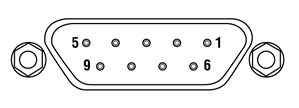
| Pin | Function | Connection |
|---|---|---|
| 1 | N.C. | Not Connected |
| 2 | TxD | RS232: Connect to PC Terminal RxD (PC DE-9 Pin 2) |
| 3 | RxD | RS232: Connect to PC Terminal TxD (PC DE-9 Pin 3) |
| 4 | N.C. | Not Connected |
| 5 | GND | RS232 Signal Ground: Connect to PC Terminal Ground (PC DE-9 Pin 5) |
| 6,7,8,9 | N.C. | Not Connected |
DE-9 RS232 Connector

| Pin | Function | Connection | Pin | Function | Connection |
|---|---|---|---|---|---|
| 1 | I/O 0 | Input/Output Ports (Alternative Function: Pass/Fail or Disable Analog Ports) |
6 | GND | Ground |
| 2 | I/O 1 | 7 | SCL | I2C Bus Clock | |
| 3 | I/O 2 | Input/Output Port (Alternative Function: Shutter Control or Shutter Monitor) |
8 | SDA | I2C Bus Data |
| 4 | I/O 3 | Input/Output Port (Alternative Function: Logging Control or Logging Monitor) |
9 | 3V3 | Power Supply for Accessories, 3.3 V, 100 mA Max |
| 5 | TRIG | Trigger Input/Output | 10 | 5 V | Power Supply for Accessories, 5 V, 100 mA Max |
Digital I/O
10-Pin PCB Connector
| Pin | Function | Connection | Pin | Function | Connection |
|---|---|---|---|---|---|
| 1 | NTC 1 | Input External NTC 1 | 6 | GND | Ground Fan 1 |
| 2 | GND | Ground NTC 2 | 7 | TAC 1 | Optional Tacho Signal of Fan 1 |
| 3 | NTC 2 | Input External NTC 2 | 8 | FAN 2 | Supply Fan 2 |
| 4 | GND | Ground NTC 2 | 9 | GND | Ground Fan 2 |
| 5 | FAN 1 | Supply Fan 1 | 10 | TAC 2 | Optional Tacho Signal of Fan 2 |
Fan Control
10-Pin PCB Connector

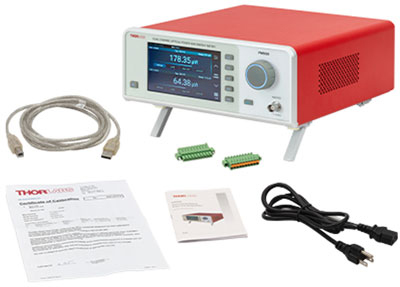
Click to Enlarge
Figure 6.1 Items Included with PM5020 (North American Power Cord Shown)
Item # PM5020 includes the following:
- Dual-Channel Benchtop Optical Power and Energy Meter Console
- USB 2.0 Cable, 2 m
- Two Printed Circuit Board Connectors: FMC1.5/10-STF-3.5
- Region-Specific Power Cord
- Quick Reference
- Certificate of Calibration
Compatible Power Meters
- Consoles:
- PM100A Analog Power and Energy Meter Console
- PM200 Legacy Touch Screen Power and Energy Meter Console
- PM100D Legacy Digital Power and Energy Meter Console
- PM100D2 and PM100D3 Digital Power and Energy Meter Consoles (Version 7.0)
- PM400 Capacitive Touchscreen Power and Energy Meter Console
- PM5020 Dual-Channel Benchtop Optical Power and Energy Meter Console (Version 4.0 or Later)
- Complete Power Meters:
- PM160, PM160T, and PM160T-HP Wireless Handheld Power Meters with Bluetooth® Technology
- PM16 Series Compact USB Power Meters
- PM60 and PM61 Fiber Optic Power Meter Series (Version 6.0 or Later)
- Interfaces:
- PM101 Series Power Meter Interfaces with External Readout (Version 2.0 or Later)
- PM102 Series Power Meter Interfaces with External Readout (Version 2.1 or Later)
- PM103 Series Power Meter Interfaces with External Readout (Version 3.0 or Later)
- PM100USB USB Interface Digital Power and Energy Meter
Other Compatible Devices
- ERM2xx Series Extinction Ratio Meters
- SPCNT Single Photon Counting Device
- TSP01 USB Temperature and Humidity Data Logger
- TSP-TH Additional Temperature Probe
- WM202 Wavelength Meter
Optical Parameter Monitor
The Optical Parameter Monitor GUI software features readout from up to eight power meters or other compatible devices, or remote wireless operation.
For details on specific software features, please see the user manual.
Users interested in the legacy Power Meter Software can find it by visiting the software page.
The PM100D2 and PM100D2 are only compatible with version 7.0. The PM101 Series Power Meters are only compatible with version 2.0 or later. The PM102 Series Power Meters are only compatible with version 2.1 or later. The PM103 Series Power and Energy Meters are only compatible with version 3.0 or later. The PM5020 Console is only compatible with version 4.0 or later. The PM60 and PM61 Power Meter Series are only compatible with version 6.0 or later.
Optical Parameter Monitor GUI Software for Touchscreen, Handheld, and USB-Interface Power Meters
Features
- Operate up to Eight Devices Simultaneously
- Record and Analyze Measurements in Real Time
- Intuitive Analog Display and Graphing Modes
- Configurable Long-Term Data Logging
- Also Supports Position Measurements with Thermal Position & Power Sensors
- Compatible with USB, Bluetooth®, Ethernet, and Serial Connections
The Optical Parameter Monitor (OPM) software GUI enables seamless control of up to eight compatible devices that are connected via USB, RS232, Ethernet, or Bluetooth®,a wireless technologyb. The latest software, firmware, drivers, and utilities for these power meters can be downloaded here.
Multiple data measurement and analysis functions are integrated into the GUI package. The interface offers a user-friendly design with minimal use of color and low brightness that is ideal for use in dark lab environments while wearing laser safety glasses. Measured data can be displayed in real time as a simulated analog needle, digital value, line graph, or bar graph. Continuously logged and short-term measurements can be recorded for data viewing and analysis at a later point. A built-in statistics mode analyzes measured data and updates continuously to reflect new measurements within the pre-determined measurement period. Beam position measurements are also supported when used with our thermal position and power sensors and a compatible power meter.
The OPM software package installs the GUI, which then can be used to control the touchscreen, handheld, or USB-interface power meters and other compatible devices. Firmware updates for supported devices are also available. Programming examples and drivers for interfacing with our power and energy meter consoles using LabVIEW, C/C++, Visual C#, and Python are installed with the software.
Please note that the OPM Software uses different drivers than the Power Meter Utilities Software and Thorlabs recommends using the new driver TLPM.dll. For users who wish to use the legacy Power Meter Software or use custom software designed using the older PM100D.dll driver, a Power Meter Driver Switcher program is included for easy swapping of the installed driver between the two versions.
- Bluetooth is a registered trademark of Bluetooth Sig, Inc.
- The PM100D3, PM61 Series, PM160, PM160T, and PM160T-HP power meters are equipped with Bluetooth connections.
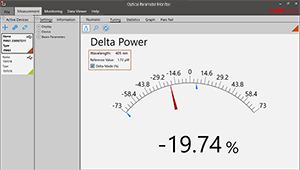
Click to Enlarge
Figure 149B Tuning Mode
Simulated analog needle and digital measurement value provided. Delta Mode, enabled here, shows the fluctuation range during the measurement period.
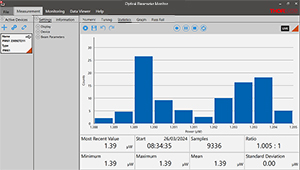
Click to Enlarge
Figure 149C Statistics Mode
Calculate numerical statistics for a pre-determined measurement period. The panel displays the analyzed values in a bar graph and the results as numerical values.
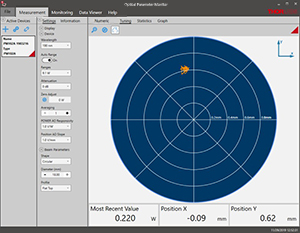
Click to Enlarge
Figure 149D Position Tuning Mode
Tuning mode can be used with a thermal position and power sensor to aid in beam alignment, if the connected power meter supports it.
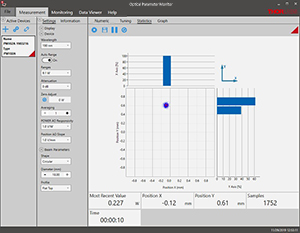
Click to Enlarge
Figure 149E Position Statistics Mode
Statistics mode also provides aggregate information for thermal position and power sensors, if they are supported.
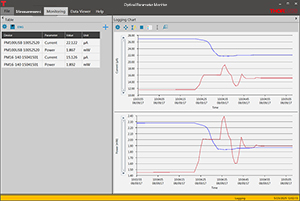
Click to Enlarge
Figure 149F Monitoring Mode
Enable long-term measurement and simultaneous recording from up to eight power meters. Save data as .csv files for later processing while measurement results are displayed in a graph in real time.
Standard Photodiode Sensor Mounting Options
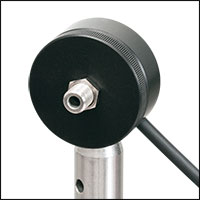
Click to Expand
Figure 818B S120C and S120-SMA Fiber Adapter
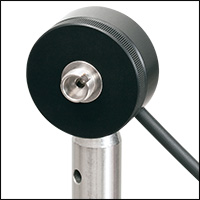
Click to Expand
Figure 818A S120C and S120-FC Fiber Adapter
The compact design of Thorlabs' Standard Photodiode Sensors allows easy integration into existing setups. Typical mounting configurations including post, cage, and lens tube options are available. Shown on this page are several different choices for mounting these sensors.
The standard photodiode sensors are compatible with all S120-xx series fiber adapters. FC/PC and SMA adapters are shown in Figures 818A and 818B. Adapters for FC/APC, SC, LC, and ST connections are also available.
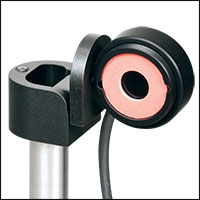
Click to Expand
Figure 818D S120C and Flip Mount
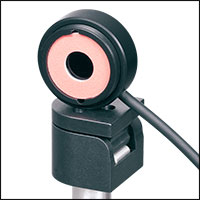
Click to Expand
Figure 818C S120C and Flip Mount
Flip mounts are convenient for quick power measurements from a static location. The sensor can be placed in the path of the laser beam for the power measurement and flipped down during normal operation of the system.
FM90(/M) Right-Angle Flip Mounts are shown in Figures 818C and 818D. Thorlabs also offers the TRB1(/M) Articulating Post Mount. The lockable articulating mount offers adjustable positioning of the sensor head.
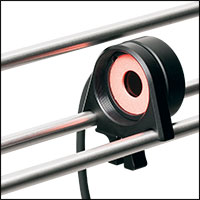
Click to Expand
Figure 818F S120C and QRC1A
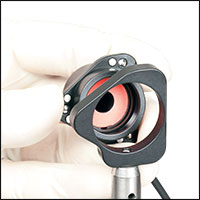
Click to Expand
Figure 818E S120C and KB1P
The standard photodiode sensors also feature externally SM1-threaded connections on the front face. The SM1 threading provides easy mounting to 1" lens tube systems and quick-release mounts.
Shown in Figures 818E and 818F are the KB1P(/M)
Note: Due to the thickness of the S12xC sensor, the QRC1A and CP44F (shown below) quick-release mounts can only be fully removed from the cage system by backing them off an open end. The two mounts are easily removed from the cage system if only three cage rods are used; see Figure 818F.
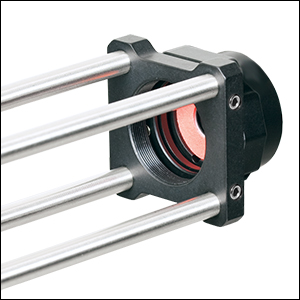
Click to Expand
Figure 818G S120C and CP44F
Thorlabs also offers the CP44F 30 mm Cage Plates with Quick-Release Mounts. These mounts feature magnetically coupled front and back plates for easy and repeatable mounting.
Note: Like the QRC1A, the CP44F cannot be removed from a closed cage system.
Slim Photodiode Sensor Mounting Options
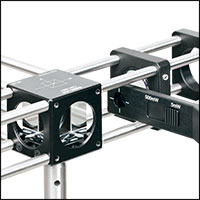
Click to Expand
Figure 818H S130C Sensor in a 30 mm Cage
Thorlabs' Slim Photodiode Sensors are designed to fit into space-restricted environments such as 30 mm cage systems and optic-dense free-space arrangements.
Shown in Figure 818H is a S130C Sensor inserted into a 30 mm cage system. The application shown highlights the ease with which the sensor can be inserted into the cage, and the minimal space needed to take a power measurement.
The slim photodiode sensors may also be mounted on a TRB1(/M) Articulating Mount. This mount allows repeatable insertion of the sensor into tight optic arrangements. After the measurement is made, the sensor may be rotated out of the beam path for normal operation.
Compact Slim Photodiode Sensor Mounting Options
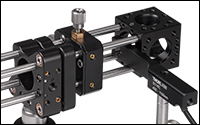
Click to Expand
Figure 818I S116C Sensor in a 16 mm Cage
Thorlabs' Compact Slim Photodiode Sensors are designed to fit into even tighter spaces such as 16 mm cage systems, our slotted Ø1/2" lens tubes, and other optic-dense free-space arrangements.
Shown in Figure 818I is a S116C Sensor inserted into a 16 mm cage system. The application shown highlights the ease with which the sensor can be inserted into the cage, and the minimal space needed to take a power measurement.
The compact slim photodiode sensor has two 8-32 (M4) taps for post mounting. One tap mounts the sensor horizontally, as seen in Figure 818I, and one allows it to be mounted vertically. The sensor may also be mounted on a TRB1(/M) Articulating Mount. This mount allows repeatable insertion of the sensor into tight optic arrangements. After the measurement is made, the sensor may be rotated out of the beam path for normal operation.
Microscope Slide Photodiode Sensor Mounting Options
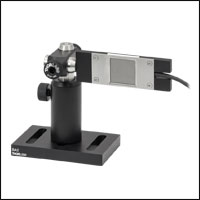
S170C Mounted on a Post
Figure 818K The S170C may be post mounted via the 8-32 (M4 x 0.7) tap in the side of the housing.
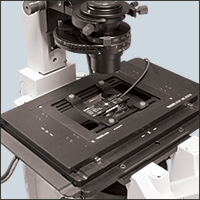
Click to Expand
Figure 818J S170C in a Microscope Slide Holder
Thorlabs' Microscope Slide Power Sensors are designed so they can be mounted directly in a microscope slide holder. The 76.0 mm x 25.2 mm x 5.0 mm sensor head has the same footprint as a standard microscope slide and is compatible with most standard upright and inverted microscopes. Figure 818J shows the S170C power sensor flipped over so that the engraved back of the housing can be used for alignment.
The S170C and NS170C power sensors also have an 8-32 (M4 x 0.7) tap for post mounting. In Figure 818K, an RA90(/M) Right-Angle Clamp is used with two Ø1/2" posts to mount the S170C sensor head in a horizontal orientation.
Integrating Sphere Photodiode Sensor Mounting Options
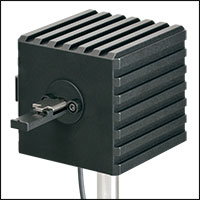
Click to Expand
Figure 818M S140C and S140-BFA Fiber Adapter
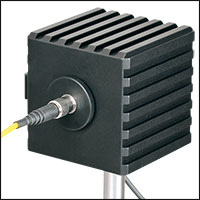
Click to Expand
Figure 818L S140C and S120-FC Fiber Adapter
Thorlabs' Integrating Sphere Photodiode Sensors provide a low-loss cavity for diverging, non-uniform, or off-axis beam measurements. These integrating spheres are ideal for all fiber-based applications due to the beam divergence at the end of the fiber.
Shown in Figure 818L is an S140C Integrating Sphere with an S120-FC Fiber Adapter and shown in Figure 818M is an S140C with an S140-BFA Bare Fiber Adapter. The bare fiber adapter features a mounting clamp and light shield to decrease interference from ambient light.
Compact Fiber Photodiode Sensor Mounting Options
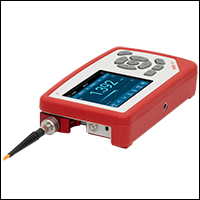
Click to Expand
Figure 818O PM100D2 with S150C Sensor

Click to Expand
Figure 818N S150C Sensor with FC and SMA Connectors
Thorlabs' Compact Fiber Photodiodes are the ideal choice for a portable, fiber-coupled power meter. The S15xC sensors are compatible with a wide variety of fiber connections. PM20-xx adapters are available to couple FC, APC, SMA, ST, SC, and LC connectors with the sensors. Shown in Figure 818N is an S150C Sensor with FC and SMA connector adapters.
Shown in Figure 818O is a PM100D2 console with an S150C sensor connected to an FC connectorized optical fiber. This setup is ideal for portable use in the lab or in the field.
Pyroelectric Energy Sensor Mounting Options
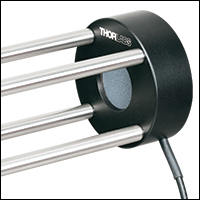
Click to Expand
Figure 818P ES220C Mounted on 30 mm Cage Rods
Thorlabs' Pyroelectric Energy Sensors are ideal for measuring pulsed sources. These pyroelectric sensors provide direct energy readings for those sources. The sensors are designed to handle medium- to high-energy pulses from excimer, YAG, and other high-power lasers.
Each sensor ships with an insulating adapter for Ø1/2" post mounting, and they are also compatible with our 30 mm cage system, as shown in Figure 818P.
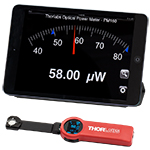
Click to Enlarge
Figure 113A The PM160 wireless power meter, shown here with an iPad mini (not included), can be remotely operated using Apple mobile devices.
This tab outlines the full selection of Thorlabs' power and energy sensors. Refer to Table 113B for power meter console and interface compatibility information.
In addition to the power and energy sensors listed below, Thorlabs also offers all-in-one, wireless, handheld power meters and compact USB power meter interfaces that contain either a photodiode or a thermal sensor, as well as power meter bundles that include a console, sensor head, and post mounting accessories.
Thorlabs offers four types of sensors:
- Photodiode Sensors: These sensors are designed for power measurements of monochromatic or near-monochromatic sources, as they have a wavelength dependent responsivity. These sensors deliver a current that depends on the input optical power and the wavelength. The current is fed into a transimpedance amplifier, which outputs a voltage proportional to the input current.
- Thermal Sensors: Constructed from material with a relatively flat response function across a wide range of wavelengths, these thermopile sensors are suitable for power measurements of broadband sources such as LEDs and SLDs. Thermal sensors deliver a voltage proportional to the input optical power.
- Thermal Position & Power Sensors: These sensors incorporate four thermopiles arranged as quadrants of a square. By comparing the voltage output from each quadrant, the unit calculates the beam's position.
- Pyroelectric Energy Sensors: Our pyroelectric sensors produce an output voltage through the pyroelectric effect and are suitable for measuring pulsed sources, with a repetition rate limited by the time constant of the detector. These sensors will output a peak voltage proportional to the incident pulse energy.
| Table 113B Console Compatibility | |||||||||
|---|---|---|---|---|---|---|---|---|---|
| Console Item # | PM100A | PM100D2 | PM100D3 | PM400 | PM5020 | PM101 Series |
PM102 Series |
PM103 Series |
PM100USB |
| Photodiode Power |  |
 |
 |
 |
 |
 |
- |  |
 |
| Thermal Power |  |
 |
 |
 |
 |
 |
 |
- |  |
| Thermal Position | - | - |  |
 |
 |
- |  |
- | - |
| Pyroelectric Energy | - |  |
 |
 a a |
 |
- | - |  |
 a a |
Power and Energy Sensor Selection Guide
There are two options for comparing the specifications of our Power and Energy Sensors. Tables 113C, 113D, 113E, and 113F sort our sensors by type (e.g., photodiode, thermal, or pyroelectric) and provide key specifications.
Alternatively, the selection guide Figures 113G and 113H arrange our entire selection of photodiode and thermal power sensors by wavelength (Figure 113G) or optical power range (Figure 113H). Each box contains the item # and specified range of the sensor. These graphs allow for easy identification of the sensor heads available for a specific wavelength or power range.
| Table 113C Photodiode Power Sensors |
|---|
| Table 113D Thermal Power Sensors |
|---|
| Table 113E Thermal Position & Power Sensors |
|---|
| Table 113F Pyroelectric Energy Sensors |
|---|
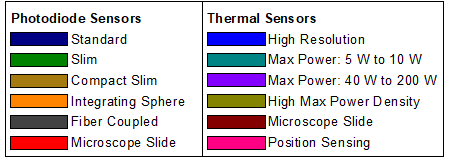
 Figure 113G Sensor Options Arranged by Wavelength Range
Figure 113G Sensor Options Arranged by Wavelength Range Figure 113H Sensor Options Arranged by Power Range
Figure 113H Sensor Options Arranged by Power RangeThorlabs offers a wide selection of power and energy meter consoles and interfaces for operating our power and energy sensors. Key specifications of all of our power meter consoles and interfaces are presented in this tab to help you decide which device is best for your application. We also offer self-contained wireless power meters and compact USB power meters.
When used with our C-series sensors, Thorlabs' power meter consoles and interfaces recognize the type of connected sensor and measure the current or voltage as appropriate. Our C-series sensors have responsivity calibration data stored in their connectors. The console will read out the responsivity value for the user-entered wavelength and calculate a power or energy reading.
- Photodiode sensors deliver a current that depends on the input optical power and the wavelength. The current is fed into a transimpedance amplifier, which outputs a voltage proportional to the input current. The photodiode's responsivity is wavelength dependent, so the correct wavelength must be entered into the console for an accurate power reading. The console reads out the responsivity for this wavelength from the connected sensor and calculates the optical power from the measured photocurrent.
- Thermal sensors deliver a voltage proportional to the input optical power. Based on the measured sensor output voltage and the sensor's responsivity, the console will calculate the incident optical power.
- Thermal position and energy sensors incorporate four thermopiles arranged as quadrants of a square. By comparing the voltage output from each quadrant, the unit calculates the beam's position.
- Energy sensors are based on the pyroelectric effect. They deliver a voltage peak proportional to the pulse energy. If an energy sensor is recognized, the console will use a peak voltage detector, and the pulse energy will be calculated from the sensor's responsivity.
The consoles and interfaces are also capable of providing a readout of the current or voltage delivered by the sensor. Select models also feature an analog output.
Consoles
| Item # | PM100A | PM100D2 | PM100D3 | PM400 | PM5020 |
|---|---|---|---|---|---|
| (Click Photo to Enlarge) | 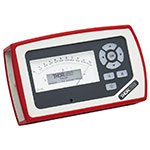 |
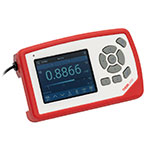 |
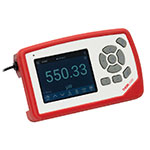 |
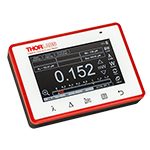 |
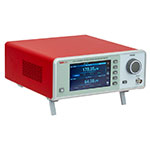 |
| Sensor Compatibility (Sensors Not Included) | |||||
| Photodiode Power |  |
 |
 |
 |
 |
| Thermal Power |  |
 |
 |
 |
 |
| Thermal Position & Power | - | - |  |
 |
 |
| Pyroelectric Energy | - |  |
 |
 a a |
 |
| Key Features | |||||
| Housing Dimensions (H x W x D) |
7.24" x 4.29" x 1.61" (184 mm x 109 mm x 41 mm) |
6.42" x 3.87" x 1.38" (163.0 mm x 98.4 mm x 35.0 mm) |
5.35" x 3.78" x 1.16" (136.0 mm x 96.0 mm x 29.5 mm) |
9.97" x 4.35" x 11.56" (253.2 mm x 110.6 mm x 293.6 mm) |
|
| Channels | 1 | 2 | |||
| External Temperature Sensor Input (Sensor Not Included) | - | - | Readout and Record Temperature Over Time | ||
| External Humidity Sensor Input (Sensor Not Included) | - | - | Readout and Record Humidity Over Time | ||
| Analog Outputb | Amplified Input Signal, SMA, 0 to 2 V, Up to 100 kHz |
Amplified Input Signal or 12-bit DAC Corrected Input Signal, SMA, 0 to 2.5 V, Up to 100 kHz |
Amplified Input Signal, 12-bit DAC Corrected Input Signal, or 14-bit DAC Corrected X-Y Position Signal, SMA, 0 to 2.5 V (Power); -2.0 to 2.0 V (Position), Up to 100 kHz |
Amplified Input Signal or DAC Corrected Input Signal, 2p Audio 3.5 mm (Adapter to BNC included), 0 to 2 V, Up to 100 kHz |
Amplified Input Signal or DAC Corrected Input Signal, 2 x BNC, -2.5 to 10 V, Up to 250 kHz. Programmable AOc, 4 x BNC, -5 to 10 V, Up to 1 kHz |
| Input/Output Ports | - | 26-Pin AUX Connector With 4 GPIO, AN OUT for Power (Analog Input Signal and 12-bit DAC) and Position Sensor (14-bit DAC), I2C, UART, and Analog and Digital Supply Voltages | 14-Pin AUX Connector With 4 GPIO, Programmable, 2 x 10 bit ADC for External Temperature, Relative Humidity Sensor, +3.3 V, ±2.5 V (100 mA Max) |
10-Pin PCB Connector, 4 Configurable Digital I/O Channels, 1 Trigger In/Out, I2C (LVTTL / TTL) |
|
| Shutter Control | - | - | - | - | Support for SH05R(/M) or SH1(/M) Optical Shutter with Interlock Input |
| Fan Control | - | - | - | - | |
| Source Spectral Correction | - | ||||
| Attenuation Correction | - | ||||
| External Trigger Input | - | - | - | ||
| Display | |||||
| Type | Mechanical Needle and LCD Display with Digital Readout | 3.5" Full Color Touchscreen Display, 640 x 480 Pixels | 4.3" Protected Capacitive Touchscreen with Color Display, 400 x 272 Pixels | 5" IPS Touchscreen LCD Display, 854 x 480 Pixels | |
| Dimensions | Digital: 1.9" x 0.5" (48.2 mm x 13.2 mm) Analog: 3.54" x 1.65" (90.0 mm x 42.0 mm) |
2.80" x 2.10" (71.0 mm x 53.3 mm) |
3.7" x 2.1" (95 mm x 54 mm) |
4.32" x 2.43" (109.7 mm x 61.6 mm) |
|
| Refresh Rate | 20 Hz | 50 Hz | 10 Hz (Numerical) 25 Hz (Analog Simulation) |
25 Hz | |
| Measurement Viewsd | |||||
| Numerical | |||||
| Mechanical Analog Needle | - | - | - | - | |
| Simulated Analog Needle | - | ||||
| Bar Graph | - | ||||
| Trend Graph | - | ||||
| Statistics | |||||
| Pass/Fail | - | - | - | - | |
| Scope | - | - | - | ||
| Memory | |||||
| Type | - | eMMC Flash | NAND Flash | SD Card | |
| Size | - | 8 GB | 4 GB | 8 GB | |
| Power | |||||
| Battery | LiPo 3.7 V 2300 mAh | LiPo 3.7 V 2300 mAh | LiPo 3.7 V 2300 mAh | - | |
| External | 5 VDC via USB or Included AC Adapter | 5 VDC via USB-C Connector | 5 VDC via USB Mini B Connector | Line Voltage: 100 - 240 V | |
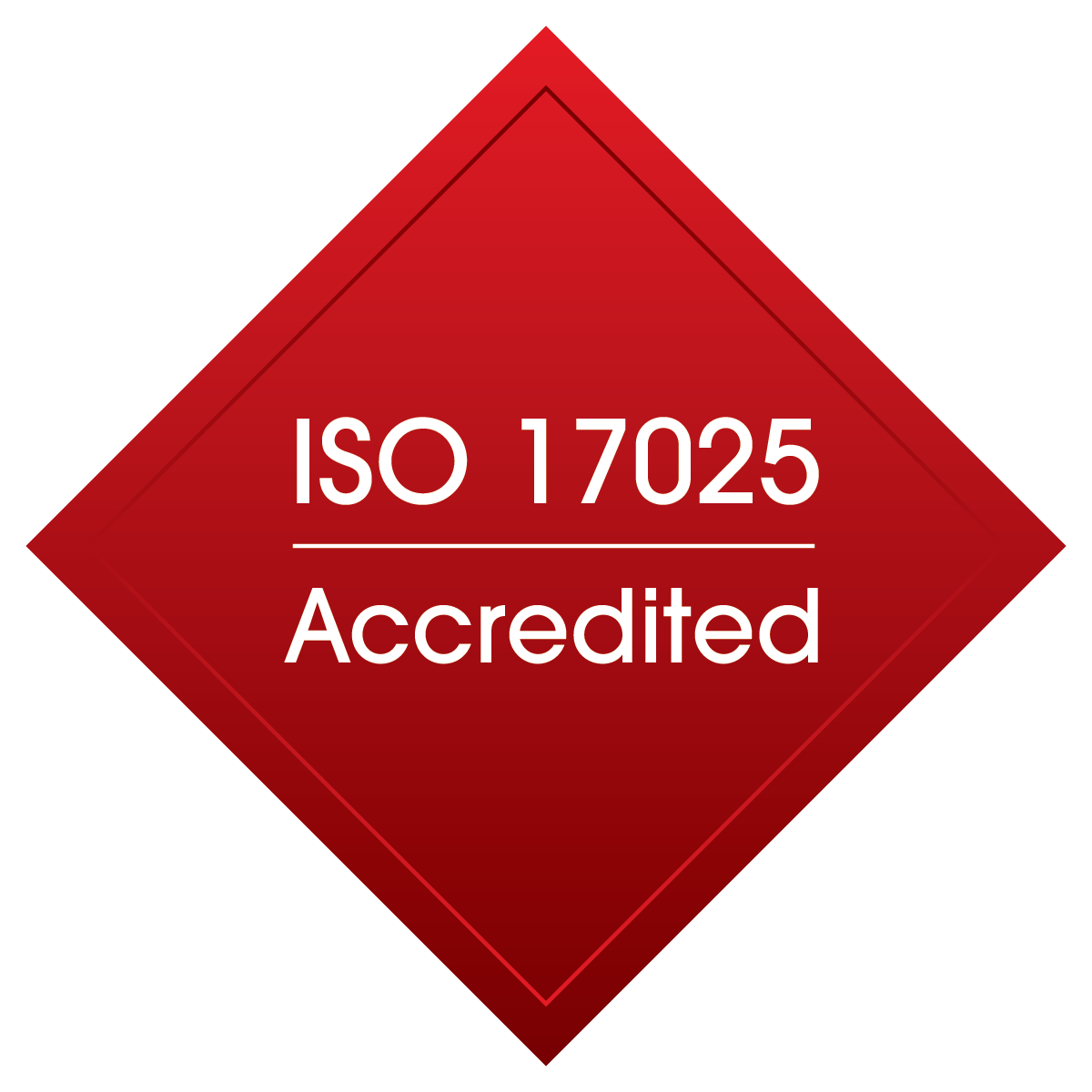
Figure 796A DAkkS-accredited calibrations are performed in accordance with DIN EN ISO/IEC 17025:2018.
Recalibration Services
Thorlabs offers two types of recalibration services in-house for our power and energy meter electronics and photodiode power sensors: ISO 17025 accredited calibrations and manufacturer calibrations. Only the manufacturer calibration is available for the NS170C microscope slide peak power sensor, our thermal power sensors, and our pyroelectric energy sensors. All new products are delivered with a manufacturer calibration by default; if an ISO 17025 accredited calibration is desired for a new device, please contact Tech Sales.
ISO 17025 accredited calibrations are performed in-house in accordance with DIN EN ISO/IEC 17025:2018. Thorlabs GmbH's calibration laboratory is accredited by the German Accreditation Body (DAkkS), the national accreditation authority of the Federal Republic of Germany. The scope of services is described here in English or German. Accredited calibrated power and/or energy meter electronics come with a dedicated certificate of calibration proving the specified accuracy and traceability of calibration data. This certification may be required in certain applications or industries, such as the medical market.
In contrast, our manufacturer calibrations are subject to the quality management requirements of ISO 9001. The certificate of calibration lists the equipment used for the calibration procedure as well as the calibration data acquired. The manufacturer calibration of a power sensor includes recalibration of a single-channel console or interface at no additional cost. If you wish to calibrate one or more sensors with a dual-channel console, each sensor and console calibration service will need to be purchased individually.
Both types of calibration can be offered for third-party equipment or adjusted for special requirements upon request. Please reach out to Tech Sales for further details.
We recommend recalibrating your Thorlabs sensor and console as a pair; however, each may be recalibrated individually. To ensure accurate measurements, we recommend recalibrating annually. To order one or more sensor recalibrations with a dual-channel console, we offer two options: either 1) fill out the Returns Material Authorization (RMA) form with each console and sensor Item # to be recalibrated and specify either manufacturer calibration or ISO 17025 accredited calibration in the "Further Details" field, or 2) separately add each recalibration service Item # offered below to your cart.
| Posted Comments: | |
Cedric Chavagnieux
(posted 2024-06-10 10:32:27.517) Hello,
I don't find the SCPI Commands for the PM5020. Is there a document that describe them ?
Do you know if the SCPI Commands of the PM400 and PM 5020 are the same?
Regards, jjadvani
(posted 2024-06-11 02:55:38.0) Dear cedric, Thank you for your feedback. Once you have downloaded the OPM software (https://www.thorlabs.com/software_pages/ViewSoftwarePage.cfm?Code=OPM ) , follow the path below to discover the SCPI recommendation for PM5020.
C:\Program Files (x86)\ThorLabs\OPM\SCPI. Then go to PM5020. There you can find SCPI commend for all our different power meters. Antonin TROGER
(posted 2024-03-29 07:13:35.563) Hi,
How can I record samples @100kS/s (in either Statistics or Scope mode) with the PM5020?
I tried using the software (Optical Power Monitor) to do this.
I configured the Statistics/Graph mode for a 10s record @100kS/s.
However, when I hit record, it always record only 1 sample.
Is it a software bug? How can I solve this? GBoedecker
(posted 2024-04-02 09:14:07.0) Thank you for your feedback! We fixed the bug in a new software and firmware version. I will send it to you. We will update the version on the website soon. Hunter Herrin
(posted 2023-06-30 09:45:18.513) I need to be able to pull information for this power meter through code - is there a way to do this that you can provide information for? The information on the website is extremely unclear. GBoedecker
(posted 2023-07-05 09:46:22.0) Thank you very much for your feedback! You can find information about the provided libraries for programming in C++, C#, Labview and Python in the Software Manual in chapter 9 "Write Your Own Application" https://www.thorlabs.de/software/MUC/OPM/v5.0/TL_OPM_V5.0_web-secured.pdf |

- Single- and Dual-Channel Measurements
- All Functions Accessible by Both Touchscreen and Physical Controls
- Remote Operation and Network Capabilities Via USB, Ethernet, or RS232
- 8 GB Internal Memory
The PM5020 Dual-Channel Optical Power and Energy Meter Console interfaces with one or two connected sensors to measure continuous wavelength and modulated light sources. This console is compatible with over 35 power, position, and energy sensors. When used with these sensors, the console will automatically detect and read the sensor calibration information stored in the sensor connector and combine this data with a user-set measurement wavelength to provide calibrated power or energy measurements. The console can also be used with third-party or custom sensors that meet the compatibility requirements outlined on the Specs tab.
Please note that sensors are not included with the PM5020 console. For information about our compatible sensors, see the sensor descriptions below. Thorlabs offers recalibration services for the PM5020 console, which can be ordered below (see Item #s CAL-PM2 and CAL-PM2D).

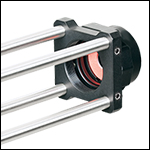
Click to Enlarge
Figure 614A S120C and CP44F Quick-Release Mount
- For General Purpose Optical Power Measurements
- Integrated Viewing Target for Easy Sensor Alignment
- Ø9.5 mm Sensor Aperture
- Sensor, Protective Cap, IR Target, and Thread Adapter Included
- Fiber Adapters Available Separately (See Table 614B)
- See the Full Web Presentation for More Information
These Standard Photodiode Power Sensors are ideal for metering low power coherent and incoherent sources from the UV to the NIR. Each NIST-Traceable, calibrated sensor features an integrated viewing target for easy alignment, enhanced shielding against electromagnetic interference, an over-temperature-alert device, and a large Ø9.5 mm sensor aperture. The sensors are compatible with 30 mm cage systems, Ø1/2" posts, and SM1 (1.035"-40) lens tubes, and are ideal for free-space and fiber-coupled sources.
Thorlabs offers recalibration services for these photodiode power sensors, which can be ordered below (see Item #s CAL-UVPD or CAL-UVPDD for UV-extended Si sensors, Item #s CAL-PD or CAL-PDD for Si sensors and Item #s CAL-IRPD or CAL-IRPDD for Ge sensors).
| Table 614B Specifications | ||||
|---|---|---|---|---|
| Item #a | S120VC | S120C | S121C | S122Ch |
| Sensor Image (Click the Image to Enlarge) |
||||
| Aperture Size | Ø9.5 mm | |||
| Wavelength Range | 200 nm - 1100 nm | 400 nm - 1100 nm | 400 nm - 1100 nm | 700 nm - 1800 nm |
| Power Range | 50 nW - 50 mW (200 nm - 450 nm) 50 nW - 20 mW (450 nm - 1100 nm) |
50 nW - 50 mW | 500 nW - 500 mW | 50 nW - 40 mW |
| Detector Type | Si Photodiode (UV Extended) | Si Photodiode | Ge Photodiode | |
| Linearity | ±0.5% | |||
| Resolutionb | 1 nW | 10 nW | 2 nW | |
| Measurement Uncertaintyc | ±3% (440 nm - 980 nm) ±5% (280 nm - 439 nm) ±7% (200 nm - 279 nm, 981 nm - 1100 nm) |
±3% (440 nm - 980 nm) ±5% (400 nm - 439 nm) ±7% (981 nm - 1100 nm) |
±5% | |
| Responsivityd (Click for Plot) | Raw Data |
Raw Data |
Raw Data |
Raw Data |
| Coating/Diffuser | Reflective ND (OD1.5)e | Reflective ND (OD1)f | Reflective ND (OD2)g | Absorptive ND (Schott NG9) |
| Head Temperature Measurement | NTC Thermistor 4.7 kΩ | |||
| Housing Dimensions | Ø30.5 mm x 12.7 mm | |||
| Cable Length | 1.5 m | |||
| Post Mountinge,f,g | Universal 8-32 / M4 Tap, Post Not Included | |||
| Aperture Thread | External SM1 (1.035"-40) | |||
| Compatible Fiber Adapters | S120-FC2, S120-FC, S120-APC2, S120-APC, S120-SMA, S120-ST, S120-LC, and S120-SC (Not Included) | |||
| Compatible Consoles | PM100A, PM100D2, PM100D3, PM400, and PM5020 | |||
| Compatible Interfaces | PM101, PM101A, PM101R, PM101U, PM103, PM103A, PM103E, PM103U, and PM100USB | |||

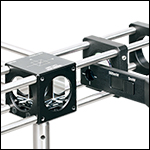
Click to Enlarge Figure 615C S130C Sensor in a 30 mm Cage

Click for Details
Figure 615B SM1A29 SM1 Thread Adapter Mounted on a S130C Sensor
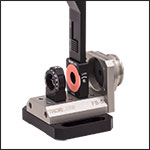
Click for Details Figure 615A S130C Photodiode Sensor Mounted in FiberBench System Using FBSM Mount
- For Optical Power Measurements in Confined Spaces
- Very Slim Design: 5 mm Thin on Sensor Side
- Ø9.5 mm Sensor Aperture
- Slideable ND Filter Automatically Changes Sensor Power Range
- Optional SM1A29 Adapter with VIS/IR Target and External SM1 Threading (More Details)
- Optional FBSM Mount with VIS/IR Target for FiberBench Systems (More Details)
- See the Full Web Presentation for More Information
These Slim Photodiode Power Sensors are designed to take optical source power measurements in locations where space and accessibility are at a premium. The 5 mm thin sensor end can fit between closely spaced optics, cage systems, and other arrangements where standard power meters may not fit. The NIST-Traceable, calibrated sensors also feature a large Ø9.5 mm sensor aperture and slideable neutral density filter for dual power ranges in one compact device.
A separately available SM1A29 adapter can be attached by two setscrews to any S130 series power sensor to mount fiber adapters, light shields, filters or any other SM1-threaded (1.035"-40) mechanics or optics. The FBSM Mount allows our S130 series power sensors to be mounted vertically into FiberBench systems for stable mounting with a minimal footprint.
Thorlabs offers recalibration services for these photodiode power sensors, which can be ordered below (see Item #s CAL-UVPD2 or CAL-UVPD2D for UV-extended Si sensors, Item #s CAL-PD2 or CAL-PD2D for Si sensors, and Item #s CAL-IRPD2 or CAL-IRPD2D for Ge sensors).
| Table 615D Specifications | |||||
|---|---|---|---|---|---|
| Item #a | S130VC | S130C | S132C | ||
| Sensor Image (Click the Image to Enlarge) |
|||||
| Aperture Size | Ø9.5 mm | ||||
| Wavelength Range | 200 nm - 450 nm | 450 nm - 1100 nm | 400 nm - 1100 nm | 700 nm - 1800 nmb | |
| Power Range (with Filter) |
500 pW - 0.5 mW (Up to 50 mW)c |
500 pW - 0.2 mW (Up to 20 mW)c |
500 pW - 5 mW (Up to 500 mW) |
5 nW - 5 mW (Up to 500 mW) |
|
| Detector Type | Si Photodiode (UV Extended) | Si Photodiode | Ge Photodiode | ||
| Linearity | ±0.5% | ||||
| Resolution | 100 pWd | 1 nWe | |||
| Measurement Uncertaintyf | ±3% (440 nm - 980 nm) ±5% (280 nm - 439 nm) ±7% (200 nm - 279 nm, 981 nm - 1100 nm) |
±3% (440 nm - 980 nm) ±5% (400 nm - 439 nm) ±7% (981 nm - 1100 nm) |
±5% | ||
| Responsivityg (Click for Plot) | Raw Data |
Raw Data |
Raw Data |
||
| Coating/Diffuser | Reflective ND (OD1.5)c | Reflective ND (OD2)h | Absorptive ND (Schott NG9/KG3)b | ||
| Housing Dimensions | 150 mm x 19 mm x 10 mm; 5 mm Thickness on Sensor Side | ||||
| Cable Length | 1.5 m | ||||
| Post Mounting | 8-32 and M4 Taps | ||||
| Adapters (Not Included) | SM1A29: Add SM1 Thread and Viewing Target to Aperture Fiber Adapters Compatible with SM1A29 Adapter: S120-FC2, S120-FC, S120-APC2, S120-APC, S120-SMA, S120-ST, S120-SC, and S120-LC FBSM: Integrate Sensor into FiberBench Setups |
||||
| Compatible Consoles | PM100A, PM100D2, PM100D3, PM400, PM100USB, and PM5020 | ||||
| Compatible Interfaces | PM101, PM101A, PM101R, PM101U, PM103, PM103A, PM103E, PM103U, and PM100USB | ||||

| Table 728A Specifications | ||
|---|---|---|
| Item #a | S116C | |
| Sensor Image (Click the Image to Enlarge) |
||
| Aperture Size | Ø6 mm | |
| Wavelength Range | 400 nm - 1100 nm | |
| Power Range | 20 nW - 50 mW | |
| Detector Type | Si Photodiode | |
| Linearity | ±0.5% | |
| Resolution | 1 nWb | |
| Measurement Uncertaintyc | ±3% (440 nm - 980 nm) ±5% (400 nm - 439 nm) ±7% (981 nm - 1100 nm) |
|
| Responsivityd (Click for Plot) |
Raw Data |
|
| Coating/Diffuser | Absorptive ND (NG9) | |
| Housing Dimensions (L x W x T) |
70.0 mm x 11.0 mm x 8.9 mm; 10.0 mm Width and 4.5 mm Thickness on Sensor Side |
|
| Active Detector Area | 7 mm x 7 mm | |
| Cable Length | 1.5 m | |
| Mounting Threads | 2 Universal 8-32 / M4 Taps (One on the Back, One on the Bottom), Posts Not Included |
|
| Adapters (Not Included) |
SM05A29: Add SM05 Thread to Aperture Fiber Adapters Compatible with SM05A29 Adapter: PM20-FC2, PM20-FC, PM20-APC2, PM20-APC, PM20-SMA, PM20-ST, PM20-SC, and PM20-LC |
|
| Compatible Consoles | PM100A, PM100D2, PM100D3, PM400, and PM5020 | |
| Compatible Interfaces | PM101, PM101A, PM101R, PM101U, PM103, PM103A, PM103E, PM103U, and PM100USB | |
- For Optical Power Measurements in Tiny Spaces Such as 16 mm Cage Systems
- Wavelength Range: 400 - 1100 nm
- Very Slim Design: 10.0 mm Wide and 4.5 mm Thin on Sensor Side
- Silicon Photodiode with Ø6 mm Sensor Aperture
- Designed for Power Measurements for Low Power Lasers
- Post Mountable via 8-32 (M4) Taps
- SM05A29 Adapter with External SM05 (0.535"-40) Threading Available Separately (More Details)
- See the Full Web Presentation for More Information
The S116C Compact Slim Photodiode Power Sensor is designed to take optical source power measurements in locations where space and accessibility are at a premium. The 4.5 mm thin photodiode sensor can fit between the rods of a 16 mm cage system, as seen in Figure 728C, as well as through the side openings of our slotted Ø1/2" lens tubes (Item #s SM05L20C and SM05L30C). This sensor also features a Ø6 mm sensor aperture.
A separately available SM05A29 adapter can be attached by two 0.05" (1.3 mm) hex setscrews to an S116C power sensor to mount fiber adapters, light shields, filters or any other SM05-threaded (0.535"-40) mechanics or optics. The adapter mounted on the S116C power sensor is shown in Figure 728B.
Each sensor is shipped with NIST- and PTB-traceable calibration data. The included data is determined with the help of a certified reference diode, which corresponds to the spectral range of the sensor to be calibrated. Thorlabs offers recalibration services for these photodiode power sensors, which can be ordered below (see Item #s CAL-PD or CAL-PDD for Si sensors).

Click to Enlarge Figure 728C S116C Sensor in a 16 mm Cage System
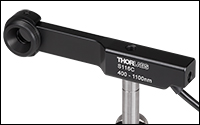
Click for Details
Figure 728B SM05A29 SM05 Thread Adapter (Sold Separately) Mounted on an S116C Sensor

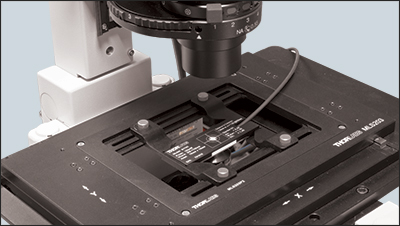
Click for Details
Figure 616A Using the engraved alignment target on the back of the sensor housing, a user can position the stage so that when the sensor is flipped, the beam strikes the center of the sensor. The S170C sensor is shown in this image.
- Designed to Measure Optical Power at the Sample Plane of a Microscope
- Silicon Photodiode with Large 18 mm x 18 mm Active Area
- Sensor Housing Dimensions: 76.0 mm x 25.2 mm x 5.0 mm
- Novel Optical Design Accommodates High NA Objectives
- Information Stored in Connector
- Sensor Data
- NIST- and PTB-Traceable Calibration Data
- Post Mountable via 8-32 (M4 x 0.7) Tap
The Microscope Slide Power Sensor Heads with silicon photodiodes are designed to measure the power at the sample plane in microscopy setups. The S170C sensor can detect wavelengths from 350 nm to 1100 nm at optical powers from 10 nW to 150 mW. The NS170C sensor is designed to measure the relative peak power of femtosecond lasers with center wavelengths from 780 nm to 1300 nm and average powers from 0.5 mW to 350 mW. Each sensor head's 76.0 mm x 25.2 mm footprint matches that of a standard microscope slide and is compatible with most standard upright and inverted microscopes.
The photodiode used in the S170C sensor has an 18 mm x 18 mm active area and is contained in a sealed housing behind a neutral density (ND) filter. A 20 mm x 20 mm indentation around the surface of the ND filter is sized to accept standard microscope cover slips. An immersion medium (water, glycerol, oil) may be placed in this well directly over the ND filter, or a cover slip may be inserted first to simplify clean up. The gap between the photodiode and the neutral density filter has been filled with an index-matching gel in order to prevent internal reflections from causing significant measurement errors when using high NA objectives with oil or water.
The NS170C sensor is designed to measure the relative peak power of two-photon lasers by utilizing a second-order nonlinear β-BBO crystal to convert incident ultrafast NIR pulses into their visible second harmonic. Shortpass filters underneath the β-BBO crystal reject the residual NIR light, allowing only the second harmonic light to transmit down to a large area silicon photodiode sensor. At the entrance of the sensor is a 170 µm thick cover glass sealed to the sensor housing, allowing the sensor to be used with dry, water immersion, and oil immersion objectives. The working distance from the top of the cover glass to the β-BBO crystal is 0.22 mm.
The bottom of each sensor housing features a laser-engraved grid to aid in aligning and focusing the beam. In standard microscopes, this grid can be used for beam alignment before flipping the sensor head to face the objective for power measurements. In inverted microscopes, turn on the transmitted illuminator to align the grid on the detector housing with the beam, thereby centering the sensor in front of the objective. Alternatively, the diffusive surface of the ND filter can be used as a focusing plane.
To avoid damaging the sensor, we recommend positioning it in the light path at a location where the beam is not focused. It is important not to exceed the Max Average Power Density over the beam's spot size for the S170C sensor, and the Max Peak Power Density for the NS170C sensor (see Specs tab).
Each sensor is shipped with NIST- or PTB-traceable calibration data. The included data will match the calibration certification of the photodiode used to test the individual sensor. Sensor specifications and the included NIST- or PTB-traceable calibration data are stored in non-volatile memory in the sensor connector and can be read out by the latest generation of Thorlabs power meters. Please note that the NS170C sensor's NIST and PTB calibration is for the visible light incident on the detector; however, the magnitude of that visible light is specific to the illumination conditions of the NIR femtosecond pulses. We recommend yearly recalibration to ensure accuracy and performance, which can be ordered below (see Item #s CAL-PD or CAL-PDD for the S170C sensor, and Item # CAL-NS for the NS170C sensor). Please contact Tech Support for more information.
The complete set of specifications are presented on the Specs tab. Thorlabs also offers a Microscope Slide Sensor Head with a thermal sensor; the full presentation can be found here.
| Item #a | S170C | NS170C |
|---|---|---|
| Sensor Image (Click Image to Enlarge) |
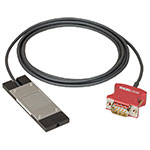 |
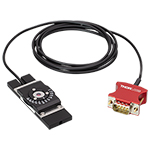 |
| Dimensions | 76.0 mm x 25.2 mm x 5.0 mm (2.99" x 0.99" x 0.20") |
Base: 76.0 mm x 25.2 mm x 5.0 mm (2.99" x 0.99" x 0.20") Overall: 76.0 mm x 30.0 mm x 11.0 mm (2.99" x 1.18" x 0.43") |
| Active Detector Area | 18 mm x 18 mm | |
| Input Aperture | 20 mm x 20 mm | Ø4.5 mm |
| Wavelength Range | 350 nm - 1100 nm | Laser: 780 nm - 1300 nm SHG: 390 nm - 650 nm |
| Optical Power Working Range | 10 nW - 150 mW | Laser: 0.5 mW - 350 mWb SHG: 10 nW - 5 mW |
| Max Peak Power Densityc | - | 10 TW/cm2 |
| Detector Type | Silicon Photodiode | Second-Order Nonlinear Crystal with Silicon Photodiode |
| Linearity | ±0.5% | ±0.5%d |
| Resolution | 1 nWe | 1 nWd,e |
| Measurement Uncertaintyf | ±3% (440 nm - 980 nm) ±5% (350 nm - 439 nm) ±7% (981 nm - 1100 nm) |
±3% (440 nm - 650 nm)d ±5% (390 nm - 439 nm)d |
| Responsivityg (Click for Plot) |
Raw Data |
Raw Data |
| Neutral Density Filter | Reflective (OD 1.5) | N/A |
| Cable Length | 1.5 m | |
| Mounting Thread | Universal 8-32 / M4 x 0.7 Tap, Post Not Included | |
| Compatible Consoles | PM100A, PM100D2, PM100D3, PM400, and PM5020 | |
| Compatible Interfaces | PM101, PM101A, PM101R, PM101U, PM103, PM103A, PM103E, PM103U, and PM100USB | |

| Table 617B Specifications | |
|---|---|
| Item #a | S175C |
| Sensor Image (Click Image to Enlarge) |
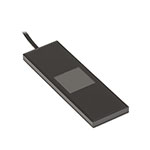 |
| Active Detector Area | 18 mm x 18 mm |
| Wavelength Range | 0.3 µm - 10.6 µm |
| Power Range | 100 µW - 2 W |
| Detector Type | Thermal Surface Absorber (Thermopile) |
| Linearity | ±0.5% |
| Resolutionb | 10 µW |
| Measurement Uncertaintyc | ±3% @ 1064 nm; ±5% @ 300 nm - 10.6 µm |
| Response Time | 3 s (<2 s from 0 to 90%) |
| Housing Dimensions | 76 mm x 25.2 mm x 4.8 mm (2.99" x 0.99" x 0.19") |
| Cable Length | 1.5 m |
| Housing Features | Integrated Glass Cover Engraved Laser Target on Back |
| Post Mounting | N/A |
| Cage Mounting | N/A |
| Aperture Thread | N/A |
| Compatible Consoles | PM100A, PM100D2, PM100D3, PM400, and PM5020 |
| Compatible Interfaces | PM101, PM101A, PM101R, PM101U, PM102, PM102A, PM102U, and PM100USB |
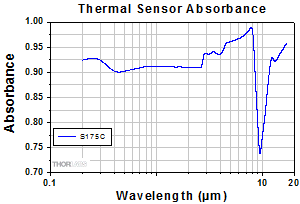
Click to Enlarge
Figure 617A Typical absorption curve for the S175C (glass and absorber). Note that this curve is representative, and the actual absorption across the spectrum will vary from unit to unit.
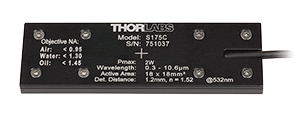
Click to Enlarge
Figure 617C The back of the S175C housing is engraved with the sensor specifications and a target for centering the beam on the sensor.
- Wavelength Range: 300 nm - 10.6 µm
- Sensitive to Optical Powers from 100 µW to 2 W
- Designed to Measure Optical Power in the Sample Plane of a Microscope
- Thermal Sensor with 18 mm x 18 mm Active Area
- 76.0 mm x 25.2 mm Footprint Matches Standard Microscope Slides
- Information Stored in Connector
- Sensor Data
- NIST- and PTB-Traceable Calibration Data
- See the Full Web Presentation for More Information
The S175C Microscope Slide Thermal Power Sensor Head is designed to measure the power at the sample in microscopy setups. The thermal sensor can detect wavelengths between 300 nm and 10.6 µm at optical powers between 100 µW and 2 W. The sensor head's 76.0 mm x 25.2 mm footprint matches that of a standard microscope slide and is compatible with most standard upright and inverted microscopes.
The thermal sensor has an 18 mm x 18 mm active area and is contained in a sealed housing behind a glass cover. An immersion medium (water, glycerol, oil) may be placed over the glass cover plate.
As seen in Figure 617C, the bottom of the sensor housing features a laser-engraved target to aid in aligning and focusing the beam. In standard microscopes, the target can be used for beam alignment before flipping the sensor head to face the objective for power measurements. In inverted microscopes, turn on the trans-illumination lamp and align the target on the detector housing with the beam; this will center the sensor in front of the objective.
Sensor specifications and the NIST- and PTB-traceable calibration data are stored in non-volatile memory in the sensor connector and can be read out by the latest generation of Thorlabs power meters. We recommend yearly recalibration to ensure accuracy and performance. Calibration may be ordered using the CAL-THPY recalibration service available below. Please contact Tech Support for more information.
Thorlabs also offers a Microscope Slide Sensor Head with a photodiode sensor for low-power, high-resolution measurements; the full presentation may be found here.

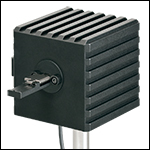
Click to Enlarge
Figure 618B S142C and S140-BFA Bare Fiber Adapter (Sold Separately)
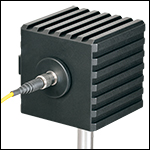
Click to Enlarge
Figure 618A S142C with the S120-FC Fiber Adapter (Included)
- For Measurements Independent of Beam Shape and Entrance Angle
- Integrating Sphere Design Acts as a Diffuser with Minimal Power Loss
- Ø5 mm, Ø7 mm, Ø12 mm, or Ø22 mm Input Sensor Aperture
- Spheres with Apertures ≤Ø12 mm Include a Removable S120-FC Fiber Adapter (FC/PC and FC/APC)
- Fiber Adapters for Terminated and Bare Fiber (See Table 618D) are Compatible with Spheres with Apertures ≤Ø12 mm
- See the Full Web Presentation for More Information
These Integrating Sphere Photodiode Power Sensors are the ideal choice for power measurements independent of beam uniformity, divergence angle, beam shape, or entrance angle, making them excellent for use with fiber sources and off-axis free space sources. They feature enhanced shielding to avoid electromagnetic interference and an over-temperature alert sensor to warn against damage and measurement errors due to overheating of the sensor.
Our integrating spheres are designed for wavelength ranges from the visible through the NIR. Sensor heads for use between 350 and 2500 nm use a single Ø1" or Ø2" sphere made from Zenith® PTFE and feature a black housing to minimize reflected light around the entrance aperture. These sensors use either a silicon photodiode for detection in the 350 - 1100 nm range or an InGaAs photodiode for detection in the 800 - 1700 nm, 900 - 1650 nm, or 1200 - 2500 nm wavelength range.
The S180C integrating sphere for 2.9 - 5.5 µm uses two connected, gold-plated Ø20 mm spheres, with an entrance port in the first sphere and a port for the MCT (HgCdTe) detector located in the second sphere. Compared to single-sphere designs, the two-sphere configuration improves device sensitivity by minimizing the internal sphere surface area while still effectively shielding the detector from direct illumination. This design reduces the effect of input angle, divergence, and beam shape on the measurement result by effectively shielding the photodiode without the use of a baffle or other shielding mechanism.
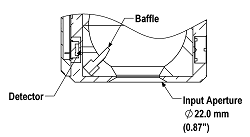
Click to Enlarge
Figure 618C A baffle on the S142CL and S145CL spheres blocks light from directly hitting the detector.
The integrating spheres with Ø5 mm, Ø7 mm, or Ø12 mm apertures feature large active detector areas, and externally SM1-threaded (1.035"-40) adapters for compatibility with the included S120-FC fiber adapter. Because of the large active detector areas of these sensors, the included S120-FC fiber adapter can be used with FC/PC- or FC/APC-terminated fiber. The externally SM1-threaded adapter can be removed using a size 1 screwdriver to place components closer to the window.
The S142CL and S145CL integrating spheres feature a large Ø22 mm input aperture and a baffle within the sphere which prevents direct illumination of the photodiode. The large aperture and baffle enable measurements of large and divergent beams, such as those emitted from LED and VCSEL light sources. The input face of the detectors have four 4-40 threads for mounting 30 mm cage system components. Additionally, insertion of a second or third port in the sensor head is possible on request, please contact Tech Support for details.
Each sensor is shipped with NIST- or PTB-traceable calibration data. The included data will match the calibration certification of the photodiode used to test the individual sensor. NIST- or PTB-traceable data is stored in the sensor connector. Thorlabs offers recalibration services for these photodiode power sensors, which can be ordered below (see Item #s CAL-PD or CAL-PDD for Si sensors, Item #s CAL-IRPD or CAL-IRPDD for InGaAs sensors, Item # CAL-MIRPD for extended InGaAs or MCT sensors, or Item # CAL-MIRPDD for extended InGaAs sensors).
| Table 618D Specifications | ||||||||||
|---|---|---|---|---|---|---|---|---|---|---|
| Item #a | S140C | S142C | S142CL | S144C | S145C | S145CL | S146C | S148C | S180C | |
| Sensor Image (Click the Image to Enlarge) |
 |
 |
 |
 |
 |
 |
 |
 |
 |
|
| Aperture Size | Ø5 mm | Ø12 mm | Ø22 mm | Ø5 mm | Ø12 mm | Ø22 mm | Ø12 mm | Ø5 mm | Ø7 mm | |
| Wavelength Range | 350 nm - 1100 nm | 400 nm - 1100 nm | 800 nm - 1700 nm | 900 nm - 1650 nm | 1200 nm - 2500 nm | 2.9 µm - 5.5 µm | ||||
| Power Range | 1 µW - 500 mW | 1 µW - 5 W | 10 µW - 5 W | 1 µW - 500 mW | 1 µW - 3 W | 10 µW - 3 W | 10 µW - 20 W | 1 µW - 1 W | 1 µW - 3 W | |
| Detector Type | Si Photodiode | Si Photodiode with Baffle | InGaAs Photodiode | InGaAs Photodiode with Baffle | InGaAs Photodiode | Extended InGaAs Photodiode | MCT (HgCdTe) Photodiode |
|||
| Linearity | ±0.5% | |||||||||
| Resolutionb | 1 nW | 10 nW | 1 nW | 10 nW | 1 nW | 10 nW | ||||
| Measurement Uncertaintyc,d |
±3% (440 nm - 980 nm) ±5% (350 nm - 439 nm) ±7% (981 nm - 1100 nm) |
±3% (440 nm - 980 nm) ±5% (400 nm - 439 nm) ±7% (981 nm - 1100 nm) |
±5% | |||||||
| Responsivitye (Click for Plot) |
Raw Data |
Raw Data |
Raw Data |
Raw Data |
Raw Data |
Raw Data |
Raw Data |
Raw Data |
Raw Data |
|
| Integrating Sphere Material (Size) |
Zenith® PTFE (Ø1") |
Zenith® PTFE (Ø2") |
Zenith® PTFE (Ø1") |
Zenith® PTFE (Ø2") |
Zenith® PTFE (Ø1") |
Gold Plating (Two Ø20 mm Spheres) |
||||
| Head Temperature Measurement |
NTC Thermistor 4.7 kΩ | |||||||||
| Housing Dimensions |
Ø45 mm x 30.5 mm | 70 mm x 74 mm x 70 mm | Ø45 mm x 30.5 mm | 70 mm x 74 mm x 70 mm | Ø45 mm x 30.5 mm | 59.0 mm x 50.0 mm x 28.5 mm |
||||
| Active Detector Area | 3.6 mm x 3.6 mm | Ø2 mm | Ø3 mm | Ø1 mm | Ø1 mm | 1 mm x 1 mm | ||||
| Cable Length | 1.5 m | |||||||||
| Mounting Thread | Separate 8-32 and M4 Taps, Posts Not Included | Universal |
Separate |
Universal |
Separate |
Universal |
||||
| Aperture Thread | Included Adapter with SM1 (1.035"-40) External Thread | None | Included Adapter with SM1 (1.035"-40) External Thread | None | Included Adapter with SM1 (1.035"-40) External Thread | |||||
| Compatible Fiber Adapters |
S120-FC (Included) S120-FC2, S120-APC2, S120-APC, S120-SMA, S120-ST, S120-SC, S120-LC, S120-25, and S140-BFA (Not Included) |
None | S120-FC (Included) S120-FC2, S120-APC2, S120-APC, S120-SMA, S120-ST, S120-SC, S120-LC, S120-25, and S140-BFA (Not Included) |
None | S120-FC (Included) S120-FC2, S120-APC2, S120-APC, S120-SMA, S120-ST, S120-SC, S120-LC, S120-25, and S140-BFA (Not Included) |
|||||
| Compatible Consoles | PM100A, PM100D2, PM100D3, PM400, and PM5020 | |||||||||
| Compatible Interfaces | PM101, PM101A, PM101R, PM101U, PM103, PM103A, PM103E, PM103U, and PM100USB | |||||||||

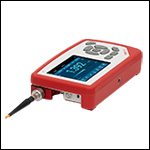
Click to Enlarge
Figure 619A PM100D2 with S150C Sensor and FC Cable
- For Fiber-Based Optical Power Measurements
- Compact Sensor Integrated into the Connector
- Integrated Design for Use in the Field and Lab
- Includes PM20-FC Fiber Adapter
- S150C and S151C Sensors also Include PM20-SMA Adapters
- Compatible FC/APC, LC/PC, SC/PC, and ST®* Fiber Adapters Also Available (See Table 619B)
- See the Full Web Presentation for More Information
The S15xC Compact Fiber Photodiode Power Sensor is designed to take power measurements from a wide variety of fiber coupled sources. The compact sensor, integrated into the power meter connector, features a unique integrated design housing the photodiode sensor, fiber coupling, and NIST-traceable data. Standard FC (and SMA - S150C and S151C) connectors are easily interchanged with a variety of standard fiber connectors.
Thorlabs offers recalibration services for these photodiode power sensors, which can be ordered below (see Item #s CAL-PD or CAL-PDD for Si sensors and Item #s CAL-IRPD or CAL-IRPDD for InGaAs sensors).
*ST® is a registered trademark of Lucent Technologies, Inc.
| Table 619B Specifications | ||||
|---|---|---|---|---|
| Item #a | S150C | S151C | S154C | S155C |
| Sensor Image (Click the Image to Enlarge) |
||||
| Included Connectors | FCb & SMA | FCb | ||
| Wavelength Range | 350 nm - 1100 nm | 400 nm - 1100 nm | 800 nm - 1700 nm | |
| Power Range | 100 pW to 5 mW (-70 dBm to +7 dBm) |
1 nW to 20 mW (-60 dBm to +13 dBm) |
100 pW to 3 mW (-70 dBm to +5 dBm) |
1 nW to 20 mW (-60 dBm to +13 dBm) |
| Detector Type | Si Photodiode | InGaAs Photodiode | ||
| Linearity | ±0.5% | |||
| Resolutionc | 10 pW (-80 dBm) | 100 pW (-70 dBm) | 10 pW (-80 dBm) | 100 pW (-70 dBm) |
| Measurement Uncertaintyd | ±3% (440 nm - 980 nm) ±5% (350 nm - 439 nm) ±7% (981 nm - 1100 nm) |
±3% (440 nm - 980 nm) ±5% (400 nm - 439 nm) ±7% (981 nm - 1100 nm) |
±5% | |
| Responsivityf (Click for Details) | Raw Data |
Raw Data |
Raw Data |
Raw Data |
| Coating/Diffuser | N/A | Absorptive ND (Schott NG3) | N/A | |
| Head Temperature Measuremente | NTC Thermistor 3 kΩ | |||
| Aperture Thread | External SM05 |
|||
| Fiber Adapters | Included: PM20-FC and PM20-SMA Optional: PM20-FC2, PM20-APC2, PM20-APC, PM20-ST, PM20-SC, and PM20-LC |
Included: PM20-FC Optional: PM20-FC2, PM20-APC2, PM20-APC, PM20-SMA, PM20-ST, PM20-SC, and PM20-LC |
||
| Compatible Consoles | PM100A, PM100D2, PM100D3, PM400, and PM5020 | |||
| Compatible Interfaces | PM101, PM101A, PM101R, PM101U, PM103, PM103A, PM103E, PM103U, and PM100USB | |||

| Table 624A Specifications | ||
|---|---|---|
| Item #a | S401C | S405C |
| Sensor Image (Click the Image to Enlarge) |
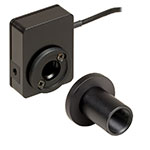 |
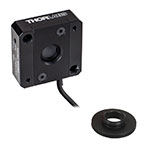 |
| Wavelength Range | 190 nm - 20 µm | 190 nm - 20 µm |
| Optical Power Range | 10 µW - 1 W (3 Wb) | 100 µW - 5 W |
| Input Aperture Size | Ø10 mm | Ø10 mm |
| Active Detector Area |
10 mm x 10 mm | 10 mm x 10 mm |
| Max Optical Power Density | 500 W/cm2 (Avg.) | 1.5 kW/cm2 (Avg.) |
| Detector Type | Thermal Surface Absorber (Thermopile) with Background Compensation |
Thermal Surface Absorber (Thermopile) |
| Linearity | ±0.5% | ±0.5% |
| Resolutionc | 1 µW | 5 µW |
| Measurement Uncertaintyd | ±3% @ 1064 nm ±5% @ 190 nm - 10.6 µm |
±3% @ 1064 nm ±5% @ 250 nm - 17 µm |
| Response Timee | 1.1 s | 1.1 s |
| Cooling | Convection (Passive) | |
| Housing Dimensions (Without Adapter) |
33.0 mm x 43.0 mm x 15.0 mm (1.30" x 1.69" x 0.59") |
40.6 mm x 40.6 mm x 16.0 mm (1.60" x 1.60" x 0.63") |
| Temperature Sensor (In Sensor Head) |
NTC Thermistor | NTC Thermistor |
| Cable Length | 1.5 m | |
| Post Mounting | Universal 8-32 / M4 Taps (Post Not Included) |
Universal 8-32 / M4 Taps (Post Not Included) |
| 30 mm Cage Mounting | - | Two 4-40 Tapped Holes & Two Ø6 mm Through Holes |
| Aperture Threads | - | Internal SM05 |
| Accessories | Externally SM1-Threaded Adapter Light Shield with Internal SM05 Threading |
Externally SM1-Threaded Adapter |
| Compatible Consoles | PM100A, PM100D2, PM100D3, PM400, and PM5020 | |
| Compatible Interfaces | PM101, PM101A, PM101R, PM101U, PM102, PM102A, PM102U, and PM100USB | |
- High Resolution of 1 μW or 5 μW
- S401C and S405C Have Thermistors Used to Monitor Temperature of Sensor Head
- S401C: Background Compensation for Low-Drift Measurements
- S405C: Accommodates Average Optical Power Densities Up to 1.5 kW/cm2;
- See the Full Web Presentation for More Information
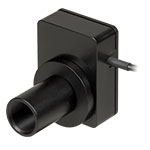
Click to Enlarge
Figure 624B S401C Thermal Sensor with Included Light Shield
Thorlabs offers two broadband thermal power sensors designed to measure low optical power sources with high resolution. Each thermal sensor's broadband coating has a flat spectral response over a wide wavelength range, as shown in Figure 624C.
An aperture size of Ø10 mm allows for easy alignment and measurement of large-spot-size laser sources. For easy integration with Thorlabs' lens tube systems and SM1-threaded (1.035"-40) fiber adapters, each sensor has either external SM1 threading or includes an externally SM1-threaded adapter.
The S401C uses active thermal background compensation to provide low-drift power measurements. This is implemented through the use of two similar sensor circuits. One sensor circuit is the type all thermal power sensors share: it measures heat flow from light absorber to heat sink. The other sensor circuit monitors the ambient temperature. It is located within the housing and measures heat flow from heat sink towards the absorber. The measurements of the two sensor circuits are subtracted, which minimizes the effect of thermal drift on the laser power measurement. (For information about how the external thermal disturbances can affect thermal power sensor readings, see the Operation tab.) The broadband coating used on this thermal sensor offers high absorption at wavelengths between 0.19 and 20 µm (shown in the graph), which makes the sensor ideal for use with aligning and measuring Mid-IR Quantum Cascade Lasers (QCLs). The included, internally SM05-threaded (0.535"-40) light shield is shown in Figure 624B.
The S405C has internal SM05 (0.535"-40) threading that is directly compatible with SM05 lens tubes, and it can also connect directly to Thorlabs' 30 mm Cage Systems.
Thorlabs offers a recalibration service for these sensors, which can be ordered below (see Item # CAL-THPY).
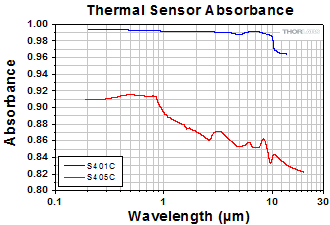
Click to Enlarge
Figure 624C The S405 shares the same absorption curve with the S415C, S425C, and S245C-L. (All are sold below.)

| Table 620A Specifications | ||
|---|---|---|
| Item #a | S415C | S425C |
| Sensor Image (Click Image to Enlarge) |
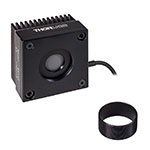 |
 |
| Wavelength Range | 190 nm - 20 µm | 190 nm - 20 µm |
| Optical Power Range | 2 mW - 10 W (20 Wb) | 2 mW - 10 W (20 Wb) |
| Input Aperture Size | Ø15 mm | Ø25.4 mm |
| Active Detector Area |
Ø15 mm | Ø27 mm |
| Max Optical Power Density |
1.5 kW/cm2 (Avg.) | 1.5 kW/cm2 (Avg.) |
| Detector Type | Thermal Surface Absorber (Thermopile) | |
| Linearity | ±0.5% | ±0.5% |
| Resolutionc | 100 µW | 100 µW |
| Measurement Uncertaintyd |
±3% @ 1064 nm ±5% @ 250 nm - 17 µm |
±3% @ 1064 nm ±5% @ 250 nm - 17 µm |
| Response Timee | 0.6 s | 0.6 s |
| Cooling | Convection (Passive) | |
| Housing Dimensions (Without Adapter) |
(2.00" x 2.00" x 1.38") |
(2.00" x 2.00" x 1.38") |
| Temperature Sensor (In Sensor Head) |
NTC Thermistor | |
| Cable Length | 1.5 m | |
| Post Mounting | Universal 8-32 / M4 Taps (Post Not Included) |
Universal 8-32 / M4 Taps (Post Not Included) |
| 30 mm Cage Mounting | - | - |
| Aperture Threads | Internal SM1 | Internal SM1 |
| Removable Heatsink | Yes | Yes |
| Accessories | Externally SM1-Threaded Adapter | Externally SM1-Threaded Adapter |
| Compatible Consoles | PM100A, PM100D2, PM100D3, PM400, and PM5020 | |
| Compatible Interfaces | PM101, PM101A, PM101R, PM101U, PM102, PM102A, PM102U, and PM100USB | |
- 100 µW Optical Power Resolution
- Thermistors Used to Monitor Temperature of Sensor Head
- Removable Heat Sinks Included
- See the Full Web Presentation for More Information
These thermal power sensors are designed for general broadband power measurements of low and medium power light sources. All include an externally SM1-threaded (1.035"-40) adapter, with threading concentric with the input aperture. The adapters are useful for mounting Ø1" Lens Tubes and Fiber Adapters (available below). The apertures of the S415C and S425C have internal SM1 threading.
These sensors operate with fast (<0.6 s) natural response times, and their removable heat sinks provide a high degree of flexibility to those interested in integrating them into custom setups or replacing the included heat sink with one that is water or fan cooled. If replacing the heat sink, please note that the replacement must provide heat dissipation adequate for the application.
Thorlabs offers a recalibration service for these sensors, which can be ordered below (see Item # CAL-THPY).
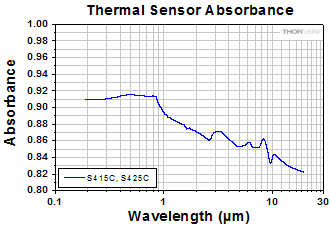
Click to Enlarge
Figure 620B The absorption curves of each of the thermal power sensors designed for use with low and medium power optical sources.

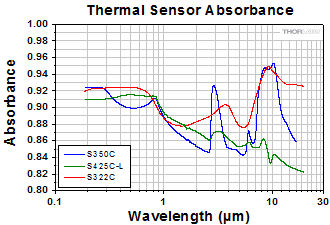
Click to Enlarge
Figure 621A The absorption curves of each of the thermal power sensors designed for use with low and medium power optical sources.
- Thermistors Used to Monitor Temperature of Sensor Head
- S322C Has 4-40 Taps for Use with Our 30 mm Cage Systems
- S350C Has Ø40 mm Aperture Well Suited to Excimer and Other Lasers with Large Spot Sizes
- S425C-L Features Removable Heat Sink
- S322C is Fan Cooled with an Optical Power Range Up to 200 W
- See the Full Web Presentation for More Information
These thermal power sensors are designed for general broadband power measurements of low and medium power light sources. With the exception of the S350C, all include an adapter with external SM1 (1.035"-40) threading concentric with the input aperture. This allows the sensors to be integrated into existing Ø1" lens tube systems in addition to being compatible with fiber adapters (available below). The aperture of the S425C-L has internal SM1 threading.
The S425C-L operates with a fast (<0.6 s) natural response time and has a removable heat sink, which provides a high degree of flexibility to those interested in integrating them into custom setups or replacing the included heat sink with one that is water or fan cooled. If replacing the heat sink, please note that the replacement must provide heat dissipation adequate for the application.
Thorlabs offers a recalibration service for these sensors, which can be ordered below (see Item # CAL-THPY).
| Table 621B Specifications | |||
|---|---|---|---|
| Item #a | S350C | S425C-L | S322C |
| Sensor Image (Click Image to Enlarge) |
 |
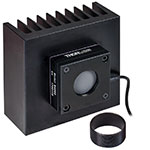 |
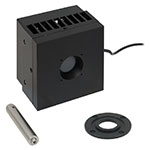 |
| Wavelength Range | 190 nm - 1.1 µm, 10.6 µm | 190 nm- 20 µm | 250 nm - 11 µm |
| Optical Power Range | 10 mW - 40 W (60 Wb) | 2 mW - 50 W (75 Wb) | 100 mW - 200 W (250 Wb) |
| Input Aperture Size | Ø40 mm | Ø25.4 mm | Ø25 mm |
| Active Detector Area |
Ø40 mm | Ø27 mm | Ø25 mm |
| Max Optical Power Density | 2 kW/cm2 (Avg.) | 1.5 kW/cm2 (Avg.) | 4 kW/cm2 (Avg., CO2) |
| Detector Type | Thermal Surface Absorber (Thermopile) | ||
| Linearity | ±1% | ±0.5% | ±1% |
| Resolutionc | 1 mW | 100 µW | 5 mW |
| Measurement Uncertaintyd | ±3% @ 1064 nm ±5% @ 190 nm - 1100 nm, 10.6 µm |
±3% @ 1064 nm ±5% @ 250 nm - 17 µm |
±3% @ 1064 nm ±5% @ 266 nm - 1064 nm |
| Response Timee | 9 s (1 s from 0 to 90%) |
0.6 s | 5 s (1 s from 0 to 90%) |
| Cooling | Convection (Passive) | Forced Air with Fanf | |
| Housing Dimensions (Without Adapter, if Applicable) |
100 mm x 100 mm x 54.2 mm (3.94" x 3.94" x 2.13") |
100.0 mm x 100.0 mm x 58.0 mm (3.94" x 3.94" x 2.28") |
100 mm x 100 mm x 86.7 mm (3.94" x 3.94" x 3.41") |
| Temperature Sensor (In Sensor Head) |
NTC Thermistor | ||
| Cable Length | 1.5 m | ||
| Post Mounting | M6 Threaded Taps, Includes Ø1/2" Post, 75 mm Long |
Universal 8-32 / M4 Taps (Post Not Included) |
M6 Threaded Taps, Includes Ø1/2" Post, 75 mm Long |
| 30 mm Cage Mounting | - | - | Four 4-40 Tapped Holes |
| Aperture Threads | - | Internal SM1 | - |
| Removable Heatsink | - | Yes | - |
| Accessories | - | Externally SM1-Threaded Adapter | Externally SM1-Threaded Adapter |
| Compatible Consoles | PM100A, PM100D2, PM100D3, PM400, and PM5020 | ||
| Compatible Interfaces | PM101, PM101A, PM101R, PM101U, PM102, PM102A, PM102U, and PM100USB | ||

| Table 622A Specifications | ||
|---|---|---|
| Item #a | S370C | S470C |
| Sensor Image (Click the Image to Enlarge) |
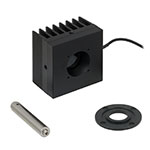 |
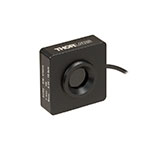 |
| Wavelength Range | 400 nm - 5.2 µm | 250 nm - 10.6 µm |
| Optical Power Range | 10 mW - 10 W (15 Wb) | 100 µW - 5 W (Pulsed and CW) |
| Input Aperture Size | Ø25 mm | Ø15 mm |
| Active Detector Area |
Ø25 mm | Ø16 mm |
| Max Optical Power Density | 35 W/cm2 (Avg.); 100 GW/cm2 (Peak) | |
| Detector Type | Thermal Volume Absorber (Thermopile) | |
| Linearity | ±1% | ±0.5% |
| Resolutionc | 250 µW | 10 µW |
| Measurement Uncertaintyd | ±3% @ 1064 nm ±5% @ 400 nm - 1064 nm |
±3% @ 1064 nm ±5% @ 250 nm - 10.6 µm |
| Response Timee | 45 s (3 s from 0 to 90%) |
6.5 s (<2 s from 0 to 90%) |
| Cooling | Convection (Passive) | |
| Housing Dimensions (Without Adapter, if Applicable) |
(2.95" x 2.95" x 2.02") |
(1.77" x 1.77" x 0.71") |
| Temperature Sensor (In Sensor Head) |
N/A | N/A |
| Cable Length | 1.5 m | |
| Post Mounting | M6 Threaded Taps, Includes Ø1/2" Post, 75 mm Long |
Universal 8-32 / M4 Tap (Post Not Included) |
| 30 mm Cage Mounting | Four 4-40 Tapped Holes | - |
| Aperture Threads | - | External SM1 |
| Accessories | - | |
| Compatible Consoles | PM100A, PM100D2, PM100D3, PM400, and PM5020 | |
| Compatible Interfaces | PM101, PM101A, PM101R, PM101U, PM102, PM102A, PM102U, and PM100USB | |
- Designed for Optical Power Measurements of Nd:YAG Lasers
- Ideal for Applications with High Peak Pulse Powers
- S370C: Ø25 mm Aperture for Large-Spot-Size Beams
- S470C: High-Sensitivity for High-Peak-Power Pulses with Low Average Power
- See the Full Web Presentation for More Information
The S370C and S470C Thermal Sensors are designed to measure short and highly energetic laser pulses. All of these units are post-mountable for free-space applications and feature NIST-traceable data stored in the sensor connector.
These thermal power sensors are unique in that they have thermal volume absorbers, where our other thermal power sensors have thermal surface absorbers. The volume absorber consists of a Schott glass filter. Incident pulses are absorbed and the heat is distributed throughout the volume. In this way, pulses that would have damaged the absorption coating of a thermal surface absorber are safely measured by these thermal volume absorbers.
The S370C features a large Ø25 mm aperture ideal for large-spot-size beams, and it is compatible with average powers from 10 mW to 10 W (CW).
In comparison, the S470C is faster, as the glass absorber volume is reduced and other design parameters have been optimized for speed. This results in a different optical power range, with the ability to measure powers down to 100 µW. The Ø15 mm aperture of the S470C is smaller, and has a lower max average power of 5 W. Its 10 µW resolution is better than the 250 µW resolution of the S370C.
Thorlabs offers a recalibration service for these sensors, which can be ordered below (see Item # CAL-THPY).
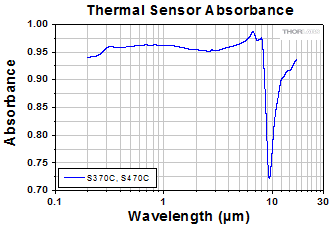
Click to Enlarge
Figure 622B This absorption curve is shown over a broader wavelength range than the sensors' operating ranges. See Table 622A for the operating wavelength range of each sensor.

| Item #a | S440C | S442C |
|---|---|---|
| Sensor Image (Click the Image to Enlarge) |
 |
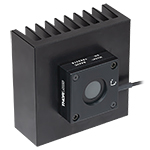 |
| Wavelength Range | 190 nm - 20 µm | |
| Optical Power Range | 0.5 mW - 5 W | 10 mW - 50 W |
| Input Aperture Size | 17 mm x 17 mm | Ø17.5 mm |
| Max Optical Power Density | 1.5 kW/cm2 | |
| Detector Type | Four Thermopiles in Quadrant Configuration | |
| Linearity | ±1% | |
| Resolutionb | 50 µW | 1 mW |
| Measurement Uncertaintyc | ±5% at 1064 nm; ±7% for 250 nm - 17 µm |
|
| Position Resolution | 5 µm | 10 µm |
| Position Accuracyd | 50 µm (Ø1 mm Circle) 200 µm (Ø6 mm Circle) |
100 µm (Ø1 mm Circle) 300 µm (Ø6 mm Circle) |
| Position Repeatabilityd | 15 µm (Ø1 mm Circle) 100 µm (Ø6 mm Circle) |
25 µm (Ø1 mm Circle) 150 µm (Ø6 mm Circle) |
| Response Timee | <1.1 s | <0.6 s |
| Cooling | Convection (Passive) | |
| Housing Dimensions (Without Adapter) |
40.6 mm x 40.6 mm x 8.9 mm (1.60" x 1.60" x 0.35") |
100.0 m x 100.0 mm x 57.8 mm (3.94" x 3.94" x 2.28") |
| Temperature Sensor (In Sensor Head) |
NTC Thermistor | |
| Cable Length | 1.5 m | |
| Post Mounting | One 8-32 / M4 Universal Tap | Two 8-32 / M4 Universal Taps |
| 30 mm Cage Mounting | Four Ø6 mm Through Holes | - |
| Aperture Threads | - | Internal SM1 (1.035"-40) |
| Accessories | - | Externally SM1-Threaded Adapter |
| Compatible Consoles | PM100D3, PM400 or PM5020 | |
| Compatible Interfaces | PM102, PM102A, or PM102U | |
- Segmented Quadrant Position-Sensing Detector
- S440C: High Sensitivity; 30 mm Cage System Compatible
- S442C: High Power; Heat Sink Included
- See the Full Web Presentation for More Information
The S440C and S442C position sensors use thermopiles to obtain high-resolution measurements of a beam's position and power. The detector area consists of four thermopile-based sensors arranged as quadrants of a square. The quadrants are mechanically coupled but electrically isolated; thus, heat is free to flow across the entire active area, but the signal from each quadrant measures the response in only that quadrant's thermopile. The XY position of the beam is determined by comparing the signal intensity measured for each quadrant.
The S440C detector is optimized for high sensitivity from 0.5 mW to 5 W. The housing features four Ø6 mm through holes for compatibility with 30 mm cage systems, as well as an 8-32 / M4 universal tap for post mounting. The S442C detector is compatible with higher power levels from 10 mW up to 50 W. The housing includes a heat sink for superior heat dissipation, as well as two 8-32 / M4 universal taps for post mounting.
Both detectors feature C-Series connectors which contain NIST- and PTB-traceable calibraion data. The sensors can be controlled using the PM100D3, PM400, or PM5020 power meter consoles or PM102 series power meter interfaces. The system can be configured to display a visual trace of the position over time, a graph of the X and Y positions over time, a table of measurement statistics, or a simple numerical readout of the incident power. See the PM100D3 and PM400 full web presentations and the PM100D3 manual and PM400 manual for details.
For information on recalibration services for these products, please contact Tech Support.
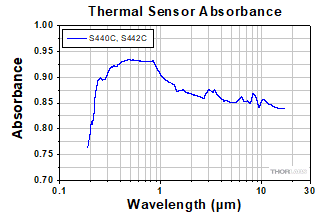
Click to Enlarge
Click Here for Raw Data
Figure 690A The wavelength range of the data in this graph is limited by the detector used during testing. The thermal position detectors are capable of operating at up to 20 µm.

| Table 623A Specifications | |||
|---|---|---|---|
| Item #a | ES111C | ES120C | ES145C |
| Sensor Image (Click the Image to Enlarge) |
 |
 |
 |
| Input Aperture Size | Ø11 mm | Ø20 mm | Ø45 mm |
| Wavelength Range | 185 nm - 25 µm | ||
| Energy Range | 10 µJ - 150 mJ | 100 µJ - 500 mJ | 500 µJ - 2 J |
| Max Repetition Rateb | 40 Hz | 30 Hz | 30 Hz |
| Max Power Density (Pulse Width) |
8 MW/cm2 (10 ns Pulse) |
||
| Max Pulse Energy Density (Pulse Width) |
0.15 J/cm2 (1 µs Pulse) |
||
| Coating (Click for Plot) | Black Broadband | ||
| Resolution | 100 nJ | 1 µJ | 1 µJ |
| Linearity | ±1% | ||
| Measurement Uncertainty | ±5% @ 190 nm - 25 µm | ±5% @ 185 nm - 25 µm | ±5% @ 185 nm - 25 µm |
| Housing Dimensions | Ø36 mm x 16 mm | Ø50 mm x 18 mm | Ø75 mm x 21 mm |
| Active Detector Area | 95.0 mm2 | 314.2 mm2 | 1590.4 mm2 |
| Cable Length | 1.5 m (60") | ||
| Post Mounting | 8-32 Mounting Thread, 8-32 and M4 Insulating Adapters Included | ||
| Cage Mounting | N/A | Four 4-40 Threaded Holes for 30 mm Cage Systems |
N/A |
| Compatible Consoles | PM100D2, PM100D3, PM400, and PM5020 | ||
| Compatible Interfaces | PM103, PM103A, PM103E, PM103U, and PM100USB | ||
- For General Purpose Optical Pulse Measurements
- Black Broadband Coating with Flat Response Over a Wide Wavelength Range
- Ø11 mm, Ø20 mm, or Ø45 mm Sensor Area
- BNC Connector for Oscilloscope Use
- Each Sensor Includes:
- C-Series Connector Adapter for Use with Compatible Thorlabs' Consoles (See Table 623A or the Console Selection Tab)
- Two Electrically Isolating Post Adapters (One Imperial and One Metric)
- See the Full Web Presentation for More Information
The ES1xxC Standard Pyroelectric Sensors are designed to measure pulsed coherent and incoherent sources. Pyroelectric sensors are not suited for CW measurements, as they convert energy from light pulses into voltage pulses. The black broadband coating on these sensors is ideal for low power, wavelength-independent energy measurements due to its flat absorption profile (see Table 623A). Large sensor areas of Ø11 mm, Ø20 mm, or Ø45 mm aid with easy alignment. The sensors can be connected directly to an oscilloscope with a 1 MΩ input resistance via the BNC connector. To accommodate higher repetition rates when connected to an oscilloscope, the load resistance can be reduced. Each energy sensor includes a BNC to C-Series adapter that contains NIST- and PTB-traceable calibration data.
Thorlabs offers a recalibration service for these energy sensors, which can be ordered below (see Item # CAL-THPY).

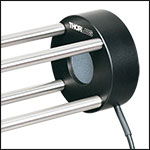
Click to Enlarge
Figure 744A ES220C Sensor Mounted in a 30 mm Cage System
- For High-Energy Optical Pulse Measurements Up to 15 J
- Ceramic Coating with High Damage Threshold for High-Energy-Density (Up to 0.45 J/cm2) Lasers
- Ø20 mm or Ø45 mm Sensor Area
- BNC Connector for Oscilloscope Use
- Each Sensor Includes:
- C-Series Connector Adapter for Use with Compatible Thorlabs' Consoles (See Table 744B or the Console Selection Tab)
- Two Electrically Isolating Post Adapters (One Imperial and One Metric)
- See the Full Web Presentation for More Information
The ES2xxC High-Energy Pyroelectric Sensors are designed to measure pulsed coherent and incoherent sources. Pyroelectric sensors are not suited for CW measurements, as they convert energy from light pulses into voltage pulses. A ceramic coating is used for high energy measurements as high as 3 J for the ES220C sensor or 15 J for the ES245C sensor. Large Ø20 mm or Ø45 mm sensor areas aid with easy alignment. The sensors can be connected directly to an oscilloscope with a 1 MΩ input resistance via the BNC connector. To accommodate higher repetition rates when connected to an oscilloscope, the load resistance can be reduced. Each energy sensor also includes a BNC to C-Series adapter that contains NIST- and PTB-traceable calibration data.
Thorlabs offers a recalibration service for these energy sensors, which can be ordered below (see Item # CAL-THPY).
| Table 744B Specifications | ||
|---|---|---|
| Item #a | ES220C | ES245C |
| Sensor Image (Click the Image to Enlarge) |
 |
 |
| Input Aperture Size | Ø20 mm | Ø45 mm |
| Wavelength Range | 185 nm - 25 µm | |
| Energy Range | 500 µJ - 3 J | 1 mJ - 15 J |
| Max Repetition Rateb | 30 Hz | 30 Hz |
| Max Power Density (Pulse Width) |
65 MW/cm2 (7 ns Pulse @ 355 nm) |
|
| Max Pulse Energy Density (Pulse Width) |
0.45 J/cm2 (7 ns Pulse @ 355 nm) |
|
| Coating (Click for Plot) | Ceramic | |
| Resolution | 25 µJ | 50 µJ |
| Linearity | ±1% | |
| Measurement Uncertainty | ±5% @ 185 nm - 25 µm | |
| Housing Dimensions | Ø50 mm x 18 mm | Ø75 mm x 21 mm |
| Active Detector Area | 314.2 mm2 | 1590.4 mm2 |
| Cable Length | 1.5 m (60") | |
| Post Mounting | 8-32 Mounting Thread, 8-32 and M4 Insulating Adapters Included | |
| Cage Mounting | Four 4-40 Threaded Holes for 30 mm Cage Systems | N/A |
| Compatible Consoles | PM100D2, PM100D3, PM400, and PM5020 | |
| Compatible Interfaces | PM103, PM103A, PM103E, PM103U, and PM100USB | |

- For Measurements of Repetition Rates Up to 10 kHz
- Two Coating Options:
- Black Broadband Coating with Flat Response from 185 nm to 25 µm
- Metal Coating for 185 nm to 2.5 µm to Support Detecting Repetition Rates Up to 10 kHz
- Ø8 mm or Ø12 mm Sensor Areas
- BNC Connector for Oscilloscope Use
- Includes C-Series Connector Adapter for Use with Compatible Thorlabs' Consoles (See Table 743A or the Console Selection Tab)
- See the Full Web Presentation for More Information
These Fast Pyroelectric Sensors are designed to measure pulsed coherent and incoherent sources with high repetition rates up to 10 kHz. Pyroelectric sensors are not suited for CW measurements, as they convert energy from light pulses into voltage pulses. The ES3xxC sensors have a black broadband that provides a flat response from 185 nm to 25 µm, and, depending on the sensor size, can support measurements of repetition rates up to 1 kHz. The metal-coated E4xxC sensors can detect repetition rates up to 10 kHz, depending on the sensor size, over a more limited wavelength range of 185 nm to 2.5 µm. Ø8 mm or Ø12 mm sensor areas are available, and each input aperture has external SM1 (1.035"-40) threads for compatibility with our SM1-threaded lens tubes. These energy sensors have BNC connectors for connection to an oscilloscope with a 1 MΩ load input resistance; using these sensors with a different load resistance may lead to reduced speed. A BNC to C-Series adapter containing NIST- and PTB-traceable calibration data is also included with each sensor.
Thorlabs offers a recalibration service for these energy sensors, which can be ordered below (see Item # CAL-THPY).
| Table 743A Specifications | ||||
|---|---|---|---|---|
| Item #a | ES308C | ES312C | ES408C | ES412C |
| Sensor Image (Click the Image to Enlarge) |
 |
 |
 |
 |
| Input Aperture Size | Ø8 mm | Ø12 mm | Ø8 mm | Ø12 mm |
| Wavelength Range | 185 nm - 25 µm | 185 nm - 2.5 µm | ||
| Energy Range | 500 µJ - 1 J | 100 µJ - 1 J | 100 µJ - 1 J | 50 µJ - 500 mJ |
| Max Repetition Rateb | 1 kHz | 250 Hz | 10 kHz | 2 kHz |
| Max Power Density (Pulse Width) |
8 MW/cm2 (10 ns Pulse) |
5 MW/cm2 (10 ns Pulse) |
||
| Max Pulse Energy Density (Pulse Width) |
80 mJ/cm2 (10 ns Pulse) |
50 mJ/cm2 (10 ns Pulse) |
||
| Coating (Click for Plot) | Black Broadband | Metal | ||
| Resolution | 5 µJ | 1 µJ | 1 µJ | 1 µJ |
| Linearity | ±1% | |||
| Measurement Uncertainty | ±5% @ 185 nm - 25 µm | ±5% @ 185 nm - 2.5 µm | ||
| Housing Dimensionsc | Ø38 mm x 15 mm | Ø38 mm x 15 mm | Ø38 mm x 15 mm | Ø38 mm x 15 mm |
| Active Detector Area | 50.3 mm2 | 113.1 mm2 | 50.3 mm2 | 113.1 mm2 |
| Cable Length | 1.5 m (60") | |||
| Post Mounting | 8-32 and M4 Combi Mounting Thread | |||
| Aperture Thread | External SM1 (1.035"-40) Thread Thread Depth: 3.0 mm (0.12") |
|||
| Compatible Consoles | PM100D2, PM100D3, PM400, and PM5020 | PM100D2, PM100D3, and PM5020 | PM100D2, PM100D3, PM400, and PM5020 | |
| Compatible Interfaces | PM103, PM103A, PM103E, PM103U, and PM100USB | PM103, PM103A, PM103E, and PM103U | PM103, PM103A, PM103E, PM103U, and PM100USB | |

| Table 236A Compatibility | |
|---|---|
| Calibration Service Item # | Compatible Sensors |
| CAL-UVPD | S120VC |
| CAL-PD | S116C, S120C, S121C, S170C, S140C, S142C, S142CL, S150C, S151C, PM16-120, PM16 |
| CAL-UVPD2 | S130VC |
| CAL-PD2 | S130C, PM16-130, PM160 |
| CAL-NS | NS170C |
| CAL-IRPD | S122C, S144C, S145C, S145CL, S146C, S154C, S155C, PM16-122, PM16-144 |
| CAL-IRPD2 | S132C |
| CAL-MIRPD | S148C, S180C |
Thorlabs offers traceable recalibration services for our photodiode optical power sensors. To ensure accurate measurements, we recommend recalibrating the sensors annually. The manufacturer calibration of a power sensor includes recalibration of a single-channel console or interface at no additional cost; this is unavailable for the accredited calibration option. If you wish to calibrate one or more sensors with a dual-channel console, each sensor and console calibration service will need to be purchased individually. For more details on these recalibration services, please click the Documents (![]() ) icons below.
) icons below.
Refer to Table 236A for the appropriate calibration service Item # that corresponds to your power sensor.
Requesting a Calibration
Thorlabs provides two options for requesting a calibration:
- Complete the Returns Material Authorization (RMA) form. When completing the RMA form, please enter your name, contact information, the Part #, and the Serial # of each item being returned for calibration; in the Reason for Return field, select "I would like an item to be calibrated." In the Further Details field, please indicate "Manufacturer Calibration" or the desired calibration part number below in order to differentiate from the ISO 17025 accredited calibration option. Once the form has been submitted, a member of our RMA team will reach out to provide an RMA Number, return instructions, and to verify billing and payment information.
- Select the appropriate sensor calibration Item # below, enter the Part # and Serial # of the sensor that requires recalibration, and then Add to Cart. If you would like a console calibrated with your sensor, repeat this process for Item # CAL-PM1 or CAL-PM2 below, entering the console Item # and Serial #. A member of our RMA team will reach out to coordinate the return of the item(s) for calibration. Note that each console calibration Item # represents the cost of calibrating a console alone; if requesting a single-channel console calibration with a sensor calibration, the appropriate discount will be applied when your request is processed. Should you have other items in your cart, note that the calibration request will be split off from your order for RMA processing.
Please Note: To ensure your item being returned for calibration is routed appropriately once it arrives at our facility, please do not ship it prior to being provided an RMA Number and return instructions by a member of our team.

| Table 791A Compatibility | |
|---|---|
| Calibration Service Item # | Compatible Sensors |
| CAL-UVPDD | S120VC |
| CAL-PDD | S116C, S120C, S121C, S170C, S140C, S142C, S142CL, S150C, S151C, PM16-120, PM16 |
| CAL-UVPD2D | S130VC |
| CAL-PD2D | S130C, PM16-130, PM160 |
| CAL-IRPDD | S122C, S144C, S145C, S145CL, S146C, S154C, S155C, PM16-122, PM16-144 |
| CAL-IRPD2D | S132C |
| CAL-MIRPDD | S148C |
Thorlabs offers ISO 17025 accredited recalibration services for our photodiode optical power sensors. If you wish to calibrate one or more sensors with a console, each sensor and console calibration service will need to be purchased individually. ISO 17025 accredited calibrations are performed in accordance with DIN EN ISO/IEC 17025:2018. Thorlabs GmbH's calibration laboratory is accredited by the German Accreditation Body (DAkkS), the national accreditation authority of the Federal Republic of Germany. The scope of services is described here in English or German. For more details on these recalibration services, please see the Recalibration tab or click the Documents (![]() ) icons below.
) icons below.
Refer to Table 791A for the appropriate calibration service Item # that corresponds to your power sensor.
Requesting a Calibration
Thorlabs provides two options for requesting a calibration:
- Complete the Returns Material Authorization (RMA) form. When completing the RMA form, please enter your name, contact information, the Part #, and the Serial # of each item being returned for calibration; in the Reason for Return field, select "I would like an item to be calibrated." In the Further Details field, please indicate "ISO 17025 Accredited Calibration" or the desired calibration part number below in order to differentiate from the manufacturer calibration option. Once the form has been submitted, a member of our RMA team will reach out to provide an RMA Number, return instructions, and to verify billing and payment information.
- Select the appropriate sensor calibration Item # below, enter the Part # and Serial # of the sensor that requires recalibration, and then Add to Cart. If you would like a console calibrated with your sensor, repeat this process for Item # CAL-PM1, CAL-PM1D, CAL-PM2, or CAL-PM2D below, entering the console Item # and Serial #. A member of our RMA team will reach out to coordinate the return of the item(s) for calibration. Note that each console calibration Item # represents the cost of calibrating a console alone; if requesting a single-channel console calibration with a sensor calibration, the appropriate discount will be applied when your request is processed. Should you have other items in your cart, note that the calibration request will be split off from your order for RMA processing.
Please Note: To ensure your item being returned for calibration is routed appropriately once it arrives at our facility, please do not ship it prior to being provided an RMA Number and return instructions by a member of our team.

| Table 317A Compatibility | |
|---|---|
| Sensor Type | Sensor Item #s |
| Thermal Power | S175C, S302Ca, S305Ca, S310Ca, S314Ca,S322C, S350C, S370C, S401C, S405C, S415C, S425C, S425C-L, S470C, PM160T, PM160T-HP, PM16-401, PM16-405 |
| Pyroelectric Energy | ES111C, ES120C, ES145C, ES220C, ES245C, ES308C, ES312C, ES408C, ES412C |
Thorlabs offers recalibration services for our Thermal Power and Pyroelectric Energy Sensors. To ensure accurate measurements, we recommend recalibrating the sensors annually. Recalibration of a single-channel power and/or energy meter console or interface is included with the recalibration of a sensor at no additional cost. If you wish to calibrate one or more sensors with a dual-channel console, each sensor and console calibration service will need to be purchased individually.
Please note that the CAL-THPY recalibration service cannot be used for our Thermal Position & Power Sensors; recalibration for these sensors can be requested by contacting Tech Support. Table 317A lists the sensors for which the CAL-THPY recalibration service is available.
Requesting a Calibration
Thorlabs provides two options for requesting a calibration:
- Complete the Returns Material Authorization (RMA) form. When completing the RMA form, please enter your name, contact information, the Part #s, and the Serial #s of all sensors or consoles being returned for calibration; in the Reason for Return field, select "I would like an item to be calibrated." All other fields are optional. Once the form has been submitted, a member of our RMA team will reach out to provide an RMA Number, return instructions, and to verify billing and payment information.
- Enter the Part # and Serial # of the item that requires recalibration below and then Add to Cart. If you would like a console calibrated with your sensor, repeat this process for Item # CAL-PM1 or CAL-PM2 below, entering the console Item # and Serial #. A member of our RMA team will reach out to coordinate the return of the item(s) for calibration. Note that each console calibration Item # represents the cost of calibrating a console alone; if requesting a single-channel console calibration with a sensor calibration, the appropriate discount will be applied when your request is processed. Should you have other items in your cart, note that the calibration request will be split off from your order for RMA processing.
Please Note: To ensure your item being returned for calibration is routed appropriately once it arrives at our facility, please do not ship it prior to being provided an RMA Number and return instructions by a member of our team. Pyroelectric energy sensors returned for recalibration or servicing must include the separate BNC to DB9 adapter, which contains the sensor EEPROM.

| Table 719A Compatibility | |
|---|---|
| Calibration Service Item # | Compatible Consoles & Interfaces |
| Single-Channel | |
| CAL-PM1 | PM100D2, PM100D3, PM100A, PM400, PM100USB, PM100Da PM101 Series, PM102 Series, PM103 Series |
| Dual-Channel | |
| CAL-PM2 | PM5020 and PM320Ea |
These traceable recalibration services are for the power and/or energy meter electronics of our consoles and interfaces. To ensure accurate measurements, we recommend recalibrating annually. The manufacturer calibration of a power sensor includes recalibration of a single-channel console or interface at no additional cost; this is unavailable for the accredited calibration option. If you wish to calibrate one or more sensors with a dual-channel console, each sensor and console calibration service will need to be purchased individually. For more details on these recalibration services, please click the Documents (![]() ) icons below.
) icons below.
Table 719A lists the power and/or energy meter consoles and interfaces that can be calibrated using the CAL-PM1 and CAL-PM2 recalibration services.
Requesting a Calibration
Thorlabs provides two options for requesting a calibration:
- Complete the Returns Material Authorization (RMA) form. When completing the RMA form, please enter your name, contact information, the Part #, and the Serial # of each item being returned for calibration; in the Reason for Return field, select "I would like an item to be calibrated." In the Further Details field, please indicate "Manufacturer Calibration" or the desired calibration part number below in order to differentiate from the ISO 17025 accredited calibration option. Once the form has been submitted, a member of our RMA team will reach out to provide an RMA Number, return instructions, and to verify billing and payment information.
- Select the appropriate Item # below, enter the Part # and Serial # of the item that requires recalibration, and then Add to Cart. If you would like to calibrate one or more sensors with your console, repeat this process for the appropriate sensor recalibration service above, entering the console Item # and Serial #. A member of our RMA team will reach out to coordinate return of the item(s) for calibration. Note that each console calibration Item # represents the cost of calibrating a console alone; if requesting a single-channel console calibration with a sensor calibration, the appropriate discount will be applied when your request is processed. Should you have other items in your cart, note that the calibration request will be split off from your order for RMA processing.
Please Note: To ensure your item being returned for calibration is routed appropriately once it arrives at our facility, please do not ship it prior to being provided an RMA Number and return instructions by a member of our team.

| Table 792A Compatibility | |
|---|---|
| Calibration Service Item # | Compatible Consoles & Interfaces |
| Single-Channel | |
| CAL-PM1D | PM100D2, PM100D3, PM100A, PM400, PM100USB, PM100Da PM101 Series, PM102 Series, PM103 Series |
| Dual-Channel | |
| CAL-PM2D | PM5020 |
These ISO 17025 accredited recalibration services are for the power and/or energy meter electronics of our consoles and interfaces. If you wish to calibrate one or more sensors with a console, each sensor and console calibration service will need to be purchased individually. ISO 17025 accredited calibrations are performed in accordance with DIN EN ISO/IEC 17025:2018. Thorlabs GmbH's calibration laboratory is accredited by the German Accreditation Body (DAkkS), the national accreditation authority of the Federal Republic of Germany. The scope of services is described here in English or German. For more details on these recalibration services, please see the Recalibration tab or click the Documents (![]() ) icons below.
) icons below.
Table 792A lists the power and/or energy meter consoles and interfaces that can be calibrated using the CAL-PM1D and CAL-PM2D recalibration services.
Requesting a Calibration
Thorlabs provides two options for requesting a calibration:
- Complete the Returns Material Authorization (RMA) form. When completing the RMA form, please enter your name, contact information, the Part #, and the Serial # of each item being returned for calibration; in the Reason for Return field, select "I would like an item to be calibrated." In the Further Details field, please indicate "ISO 17025 Accredited Calibration" or the desired calibration part number below in order to differentiate from the manufacturer calibration option. Once the form has been submitted, a member of our RMA team will reach out to provide an RMA Number, return instructions, and to verify billing and payment information.
- Select the appropriate Item # below, enter the Part # and Serial # of the item that requires recalibration, and then Add to Cart. If you would like to calibrate one or more sensors with your console, repeat this process for the appropriate sensor recalibration service above, entering the console Item # and Serial #. A member of our RMA team will reach out to coordinate return of the item(s) for calibration. Note that each console calibration Item # represents the cost of calibrating a console alone; if requesting a single-channel console calibration with a sensor calibration, the appropriate discount will be applied when your request is processed. Should you have other items in your cart, note that the calibration request will be split off from your order for RMA processing.
Please Note: To ensure your item being returned for calibration is routed appropriately once it arrives at our facility, please do not ship it prior to being provided an RMA Number and return instructions by a member of our team.
 Products Home
Products Home









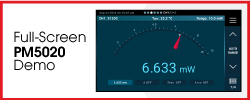
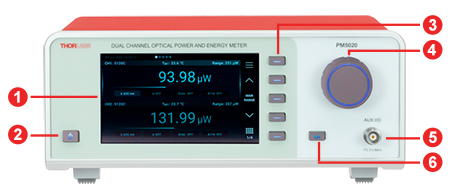
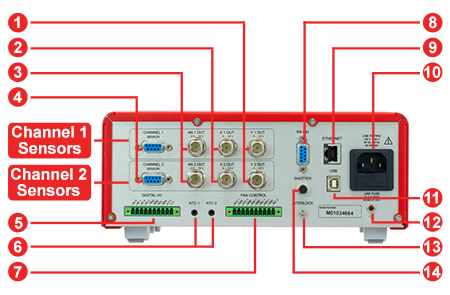
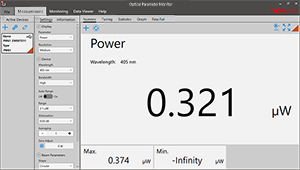

























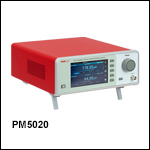
 Zoom
Zoom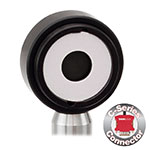
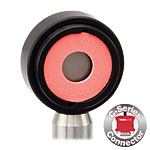
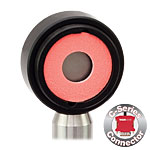
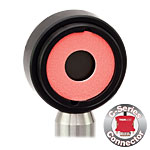
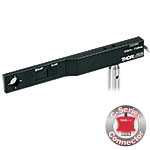
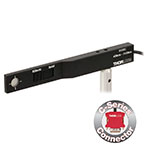
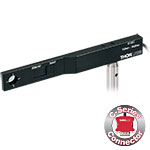
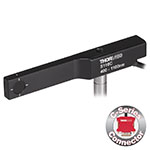
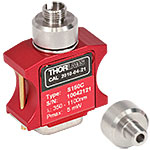
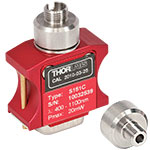
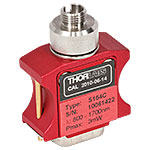
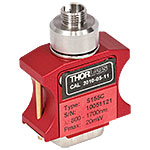
 Dual-Channel Benchtop Power & Energy Meter Console
Dual-Channel Benchtop Power & Energy Meter Console